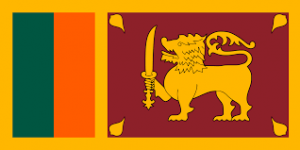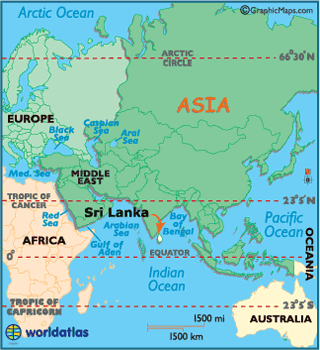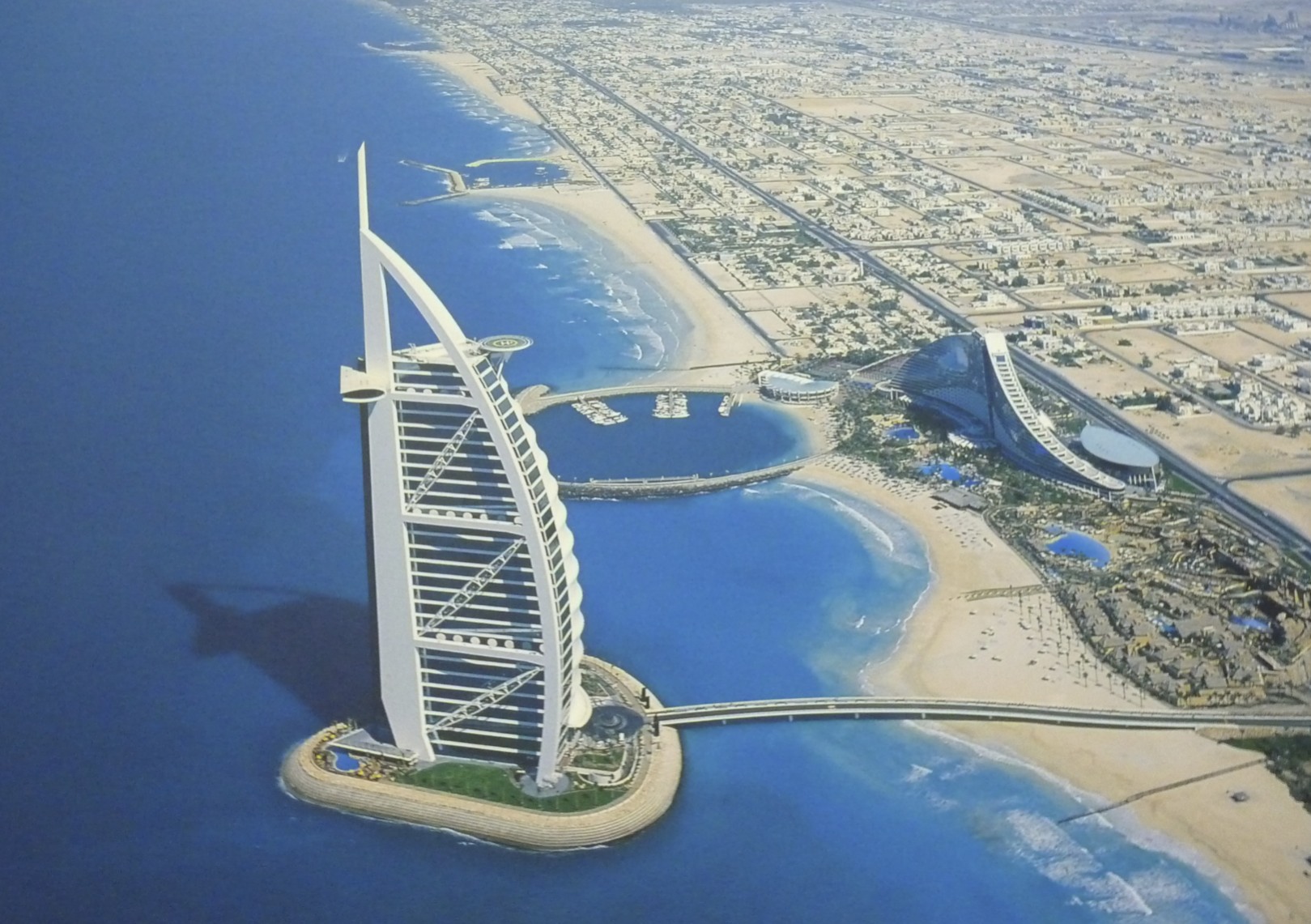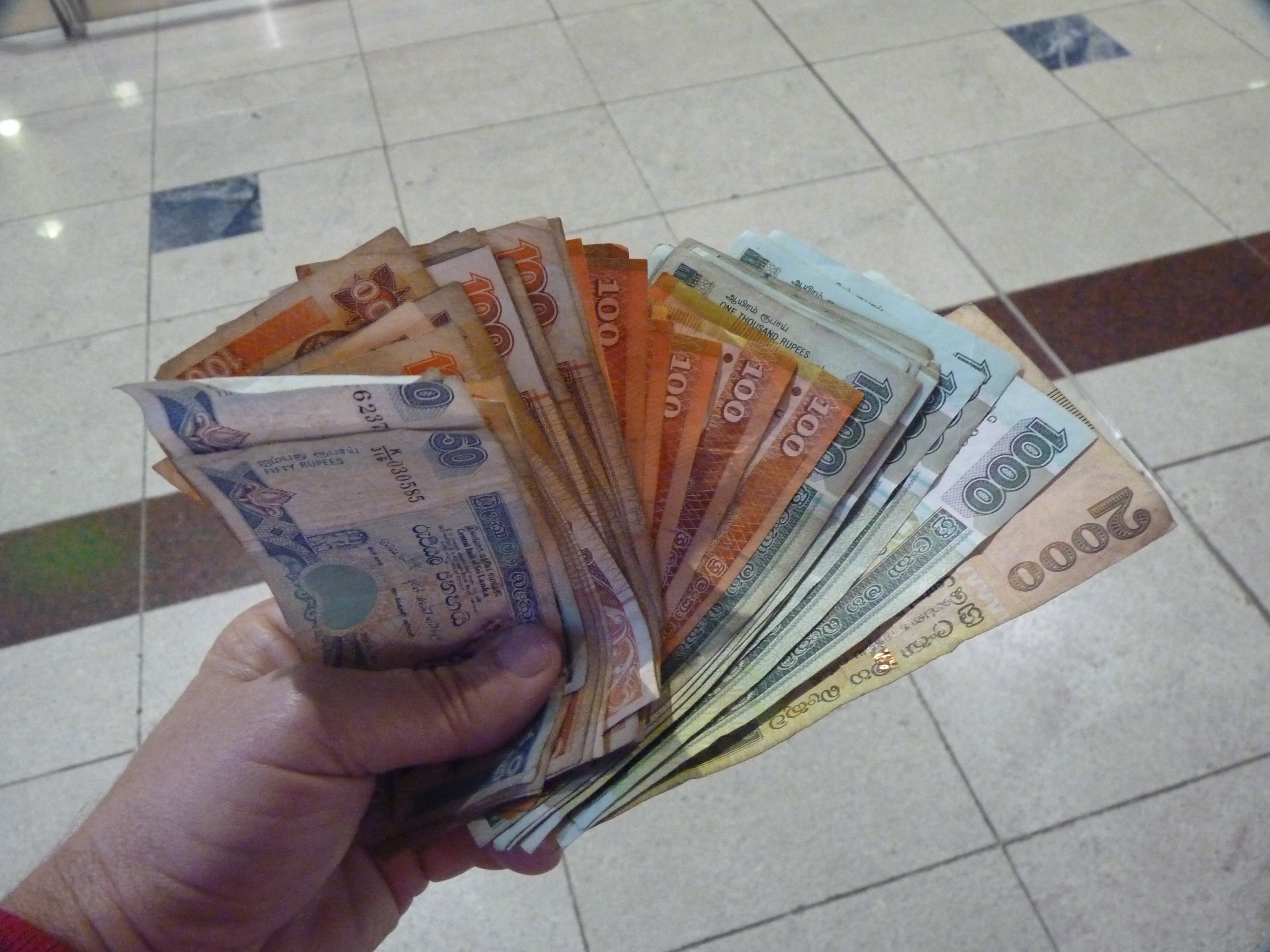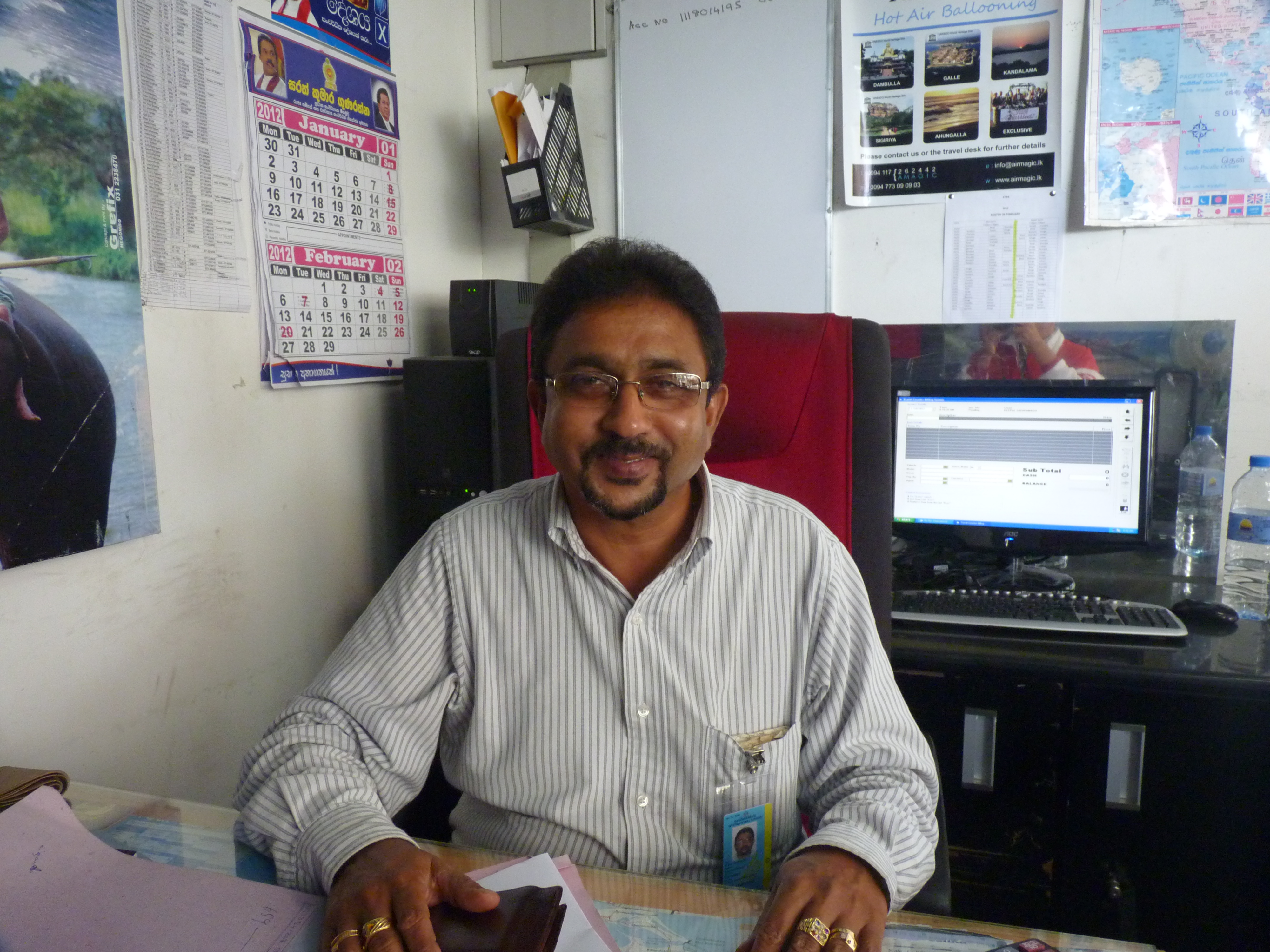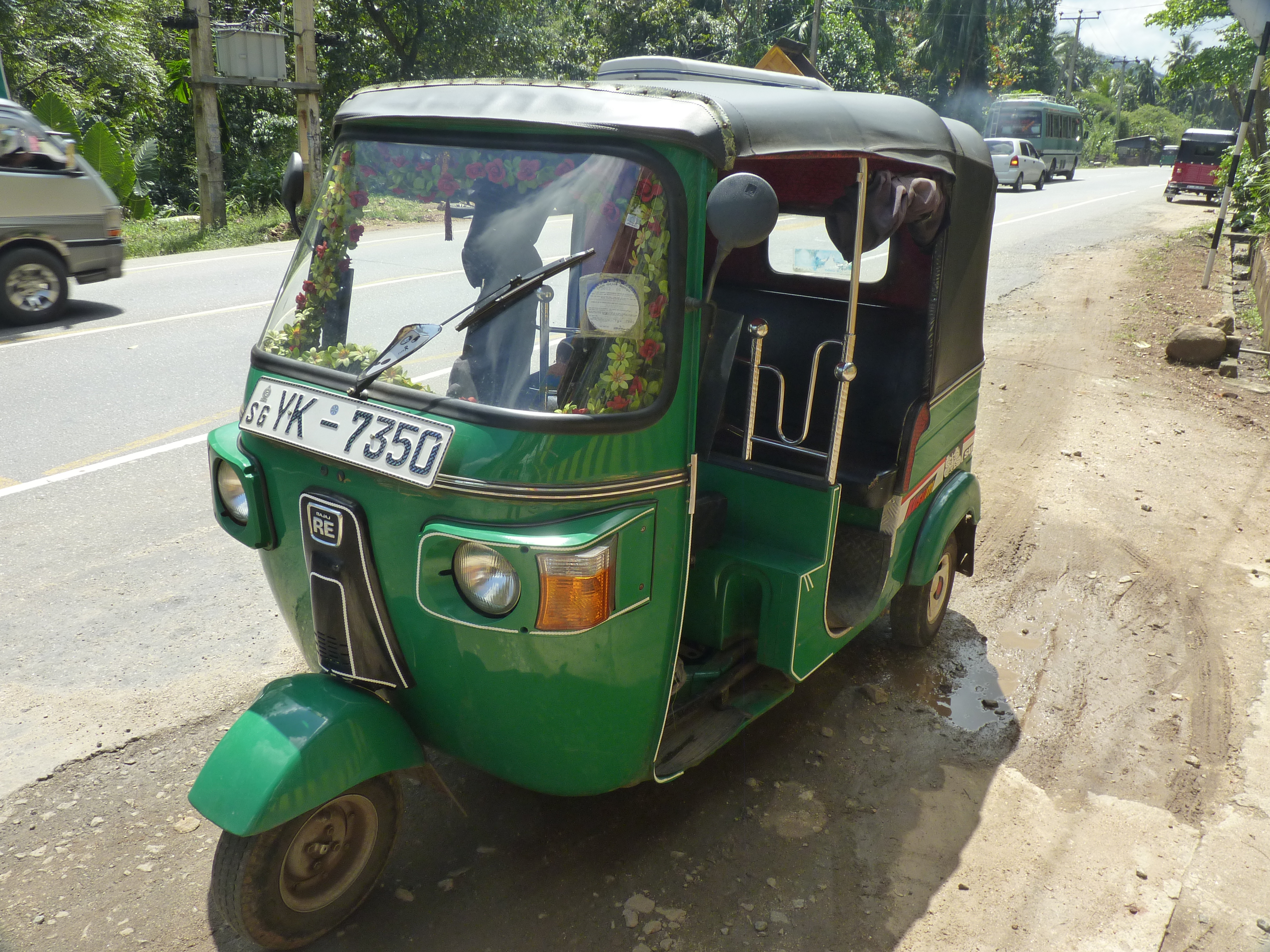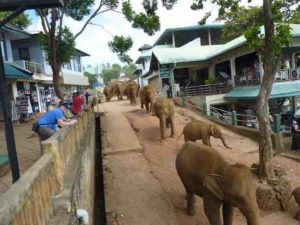Greetings from Pannala, Sri Lanka
.
.
From the travels and adventures of the “World’s #1 Trackchaser”
.
.
Trackchasing Country #57
SRI LANKA – 22,000 MILES FROM HOME AND WORTH EVERY MILE
Editor’s note: You might wonder why I take the time to provide so many details about the logistical, economic and non-racing parts of the trip. It’s simple. I hope that when people read one of my reports they can see themselves making an adventure like this. It truly is an adventure. Maybe that “spark” will come to a reader…..and before they know it they will be touching down in a Uruguay or a Malta or a Japan or somewhere far from their home…..and somewhere far from their comfort zone. Sri Lanka was a long way from my comfort zone. However, the longer I stayed there the more comfortable I became.
GREETINGS FROM PLACES ON THE WAY TO PANNALA, SRI LANKA
LIKE TO KNOW MORE ABOUT SRI LANKA?
If you’d like to learn a little more about Sri Lanka the country check out the “background” information I prepared for you. It appears behind the “background” tab. I have condensed this section so you can get a good “feel” for this Asian continent location. Most of the material comes from Wikipedia.
TODAY’S HEADLINES
I didn’t even know they raced in Sri Lanka……..details in “Pre-Trip”.
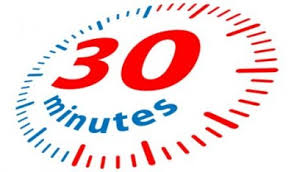
What other country operates on a ’30-minute’ time zone?……..details in “Pre-Trip”.
Having my own private driver for the entire trip was the best……..details in “Pre-Trip”
PRE-TRIP
ADVANCE PREPARATION
WHERE HAVE YOU BEEN?
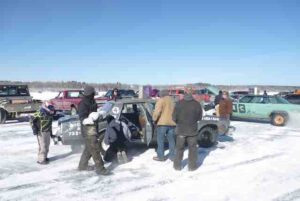
Last Sunday I was trackchasing on a frozen lake in Northern Minnesota. This Sunday, if all goes well, I will be trackchasing in the heat and humidity of a faraway place…..called Sri Lanka. Only in the hobby of trackchasing would such a thing be likely to occur.
THE RACE
I didn’t even know they raced here.
Up until a few weeks ago, I didn’t even know they raced in Sri Lanka. The best website in the world that I know of for researching international tracks is www.autoracingrecords.com. Former trackchasing commissioner, Will White, operates the site. Nevertheless, Will’s site didn’t say a thing about Sri Lanka auto racing. Maybe after my visit that will change.
When any one of these trips is planned, hours and hours as well as contacts and contacts are spent and made. After awhile I sometimes get confused on what was the first tip and what was the fifth tip let alone tips that came in about thirtieth.
From the Netherlands came news about Sri Lanka.
I believe my first knowledge of the Pannala Race Track in Pannala, Sri Lanka came from a site called “Weg Circuits” (Racing circuits from all over the world). A fellow who lives in the Netherlands operates it.
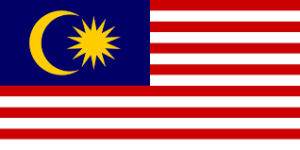
This was the first time I had ever heard of the Pannala track. Soon I was trying to find out what their race plan was. That led me to a race driver from Malaysia named simply “Dilantha”. He told me he raced once a year (I think the first of these was in 2011), in December, at a special night race in Colombo. He mentioned the race attracted some 150,000 people and was one big party.
Seeing a race in Sri Lanka, a country where no trackchaser even knew that racing existed, would be a fantastic trackchasing achievement. Going there in December would be fun since there are so few racing options during that month anywhere else. However, getting stuck in Sri Lanka during Christmas would not be as much fun. That might not go over that well at home.
It was about this time that I discovered the fellas on a forum over at www.autolanka.com. I got involved in their chat group and soon I was finding out they were racing in February. There’s not much racing in February in the U.S. so going to Sri Lanka then would be good timing.
Two weeks ago the plan was to be in Minnesota this weekend.
All of the above happened over about a two-week period. I was all set to go ice racing in Minnesota this weekend. That plan would have to be put on hold. I had two weeks to confirm the Sri Lanka race date, get a Sri Lanka visa and figure out how to get there….and back.
THE VISA
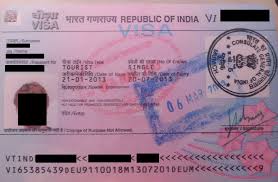
I needed an ETA and I needed it fast.
My final destination for this trip was Sri Lanka. The U.S. state department website told me I would need a special visa in order to visit. A little poking around on the Sri Lanka country website told me I could apply for an approval notice (this is not the same as a pre-authorization notice that Guy Smith requires) from the Electronic Travel Authorization System.
Soon I was filling out an online visa application and using my AMEX card to pay the $20 U.S. fee. When I applied online I was not guaranteed visa approval. I was told I would have to wait 24 hours to hear back from them. I couldn’t make any other arrangements for this trip until my visa approval was given the O.K. However, just as they promised the Sri Lanka folks followed up with me on time. I was approved. The trip planning and commitment process could move forward.
TIME ZONES
What time is it?
Any idea what time it is in Sri Lanka when it’s 8 a.m. in San Clemente? Don’t feel bad, I couldn’t answer that question either….until I studied the matter further. Of course, my iPhone can instantly tell me what time it is virtually anywhere in the world in multiple locations.
When it’s 8 a.m. in San Clemente it’s 9:30 p.m. in Colombo, Sri Lanka. Did you get that? Yes, Sri Lanka is 13 and ONE-HALF hours ahead of our place back home. What will they think of next? Whatever, when I travel I expect the unusual. I was expecting Sri Lanka to be both unusual and fun.
BOOTS ON THE GROUND

TripAdvisor people rock it.
These trips would not be doable, or if doable as successful, without the help of people who live in the country that I will be visiting. One of the best places to get quality advice from a broad-based group of people is www.tripadvisor.com.
I probably wore out my welcome asking questions on the Sri Lanka forum. Folks like Hans, Erik and Sandya, David, Travelkar88, DBM24, Aussie Cowboy, Sirene777, Tharindu and others patiently answered my queries. I wanted to know about places to stay, things to see and how would I get from point A to point B. If you don’t use TripAdvisor and you travel you’re missing out on a tremendous resource. You don’t have to travel internationally to benefit from the advice rendered at TripAdvisor.
The Sri Lankan racing community was available to help out too.
It usually pays to tap into a racing chat group for my international visits as well. Sometimes, when there is little to no English being spoken, this is difficult to do. Luckily, the people who populate www.autolanka.com conduct their business in English. They were most helpful in offering advice about the racing as well as the touring part of this trip.

I was able to speak with two Sri Lankans via phone before I left.
Finally, two local individuals jumped in with offers for help. First I received a message from Dinesh Deheragoda. He was both a racing competitor and local business owner (Ceylon Black Tea Company). Then Niroshan Pereira the president of the Ceylon Motor Sports Club (Ceylon Motor Sports Club) contacted me. I always say “go to the top” when you need help and contacts for any project worth doing.

Using my TruPhone iPhone app I was able to call these people from my office in San Clemente. For about 15 cents per minute we conversed about pit passes, touring opportunities and the best way for me to get around.
Learning by doing.
I’m not sure that each of the people who contacted me in one way or another knew how valuable their contributions were. I read hundreds of reviews. I asked question after question. No matter how much “pre-planning” I did I knew that the best way to get it all figured out was to simply go to Sri Lanka.
Once I was there all of the advice I was receiving would make even more sense. I am indebted to the people who helped me in either a big way or a small way.
THE TRANSPORTATION
Los Angeles to Washington, D.C. to Dubai to Colombo.
Does this sound easy to you? This was going to be another of those long “transits” that populate my international trackchasing resume. This trip would find me flying nearly 23,000 miles round-trip. Just the one-way outbound part of this trip would be 22 hours of flying time. I was resigned to taking it one minute at a time.
Some research found that my airline sponsorship program would get me from Los Angeles to Washington, D.C. to Dubai in the United Arab Emirates. However, as is always the case, I would be flying on a standby basis. If there was a seat open, and no other sponsored passenger with a better seniority date wanted it, I would get on the plane. Would you be willing to fly more than 9,000 miles one-way with no guarantee of a seat to get you there……. or get you back?
From Dubai I was on my own.
My airline sponsors couldn’t help me from Dubai to Colombo, Sri Lanka. That’s when I tapped into www.skyscanner.com. This is a wonderful site for those off the wall foreign located airports like Colombo, Sri Lanka.
Skyscanner told me about all the locations that had non-stop flights into and out of Colombo (CMB). Then all I had to do was find one of my sponsoring airlines that went to one of those connecting points. Dubai jumped to the head of that list. I had been to Dubai two other times, once with Carol. At one point the plan had me staying overnight in Dubai. That would have been fun. It is truly a fascinating place. However, somewhere along the line, that plan changed to just a six-hour layover in the Dubai airport.
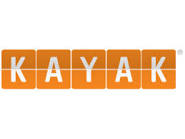
It was time to go ‘Kayaking’.
I would have to purchase a round-trip ticket from Dubai to Colombo. Once purchased that ticket would be non-changeable and non-refundable. Before I could purchase a ticket I had to get my Sri Lanka online visa request approved. While waiting for that approval the cost of the non-stop flights went up one hundred dollars!
I could have flown cheaper by connecting in Bahrain. Recall that “civil disturbances” caused a cancellation of the Formula 1 Grand Prix in Bahrain last year. Carol and I had trackchased in Bahrain in 2009.
The one-way flight time on that connection was 17 hours from the Dubai to Sri Lanka. The non-stop flight from Dubai to Sri Lanka was only five hours. I used www.kayak.com for the research required for these flights, a site I highly recommend.
There was one thing that I couldn’t lose sight of. I was flying standby to Washington, D.C. from Los Angeles and then on to Dubai. If I missed either of those flights coming or going, I would forfeit the one ticket I had purchased. Nevertheless, it seemed like a good risk to take.
The six “Ps”, ‘Proper planning prevents piss poor performance’.
For most of the two weeks that I was planning this trip, I spent 4-5 hours each day searching for information. I know that fellow international trackchasing competitor Roland Vanden Eynde says he can plan one of these things in an hour or less. However, I would submit that Roland’s plans are much more basic and expensive compared to my travels. I don’t mind putting in the time if it gives me more experiences and comes in at an acceptable cost.
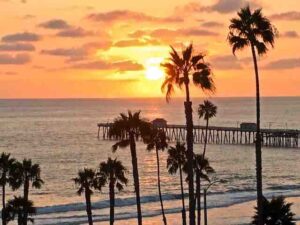
I was out the door of our simple oceanfront San Clemente bungalow at 5:22 a.m. I was looking at a 65-mile drive up to LAX, the Los Angeles International Airport. I left early giving me enough time for a Subway (sandwich that is) stop. Once at the airport I took my normal 20-minute walk from parking lot F to the terminal. I have a full airport parking sponsorship from Los Angeles World Parking, the best airport parking sponsor a trackchaser could ever want.
It was important to identify my parking location to son J.J. He was headed to London for a wedding soon and would need some clothes for the cold weather that were in storage in San Clemente. What’s one of the best things about having kids? You get to store their stuff even when they move away! I wouldn’t want it any other way.

My airline sponsors would get me from Los Angeles to Washington, D.C. by 5 p.m. or so. Despite it being the middle of the winter I was wearing cargo shorts and an Aloha t-shirt. Some folks call these shirts “Hawaiian shirts”. However, the readers of the Randy Lewis Racing Trackchaser Reports are a sophisticated lot. I know they would never refer to this attire as a Hawaiian shirt.
Flying standby I was the last person to board the plane. I didn’t mind. The plane wasn’t full. I was even upgraded to an “Economy Plus” seat. This gave me five inches of extra legroom and an open seat next to me. I had my laptop, my Bose noise-cancelling headphones and the Kenny Schrader autobiography “Gotta Race” to keep me company.
I would have a six-hour layover in Washington, D.C. before my flight to Dubai, in the United Arab Emirates, would be leaving. The layover would be good. It would give me time to fully charge my iPhone and Apple MacBook Pro. You can never have enough battery power. Battery power means information power. Information power is as good, in most cases, as cash.
CURRENCY
How would I pay for things and how much would I pay?
The official currency in Sri Lanka is the Sri Lankan Rupee. My iPhone currency app told me that one U.S. dollar would buy 114.2 Rupees. For simplicity during this trip I would divide Sri Lanka prices by one hundred (or just drop two zeros) to get the U.S. equivalent. If something was priced at 20,000 Rupees I figured it would be about $20 U.S.
Carol is normally my international banker. When I need Euros or Pounds or Canadian dollars, she goes to her secret stash (I don’t know where that is) and gets them for me. She couldn’t be a bank robber could she? Maybe a drug dealer? All I have to do is ask and soon a plastic re-sealable sandwich bag shows up on my desk with the foreign currency inside. I don’t know how she does it!
However, for less popular currencies, like the Sri Lanka Rupee, I have to fend for myself. Therefore, I made a stop at my ATM to get a fistful of twenty-dollar bills. When I have to do it this way, the expense of the trip makes a bigger impression on me. I like it better with the sandwich bags!
I was expecting that many of my Sri Lankan expenses would require local currency. TripAdvisor told me that. I would prefer to use credit cards. It’s much simpler.
WEATHER
Let it rain, I don’t care.
The weather for Colombo, Sri Lanka for the three days I was expected to be there called for warm, humid and possibly rainy weather. The high temperature would be 83-84 degrees. The rain forecast probability was 60% each day. One source told me that February is the driest month of the year in Sri Lanka. I had noticed that my Weather.com iPhone app often calls for a 60% chance of rain daily when I visit South American or Asian countries. Why? Maybe it rains a lot.
Although I never specifically asked anyone in advance of this trip, I didn’t think a little rain would slow down or cancel the racing. I would be seeing racing on an asphalt road course. Just about every country I visit races in the rain. This makes planning these long distance adventures much more palatable. If I had to fear rain cancellations, which are common in the U.S., trackchasing internationally would have a major drawback.
OVERNIGHT ACCOMMODATIONS
It’s hard to keep my ‘overhead’ under control.
I’m going to be gone on this trip for six nights. Somewhat incredibly I will be on an airplane for THREE of those nights. The other three evenings will be spent in Sri Lanka. I have a full hotel sponsorship from the Wyndham Rewards program (Ramada-Negombo) for my final night in Sri Lanka.
That means I’ll only be paying for two nights of hotels for this six-night trek. That’s good. As you know, I’m a little “short” with my season’s hotel sponsorships as it is.
There was one minor complication with my deciding on a Sri Lankan hotel. I didn’t need just a room for me. I needed some “accommodation” for my driver too. Folks, when a business gets too much overhead that can be a problem. I’ll tell you more about this unique requirement later.
My Sri Lankan rental car contact
THE RENTAL CAR
I would pick out a driver upon arrival and he would be with me for the entire trip.
I would not be renting a car in Sri Lanka. Everything that I read about such an idea consistently told me I would be “crazy” to rent a car. People told me the roads were bad, the drivers absolutely nuts and the directions lacking. I’ve had some very good trips when I have hired a driver. I was hoping this would be just like those adventures.
In the past when I have hired a driver it was only for the day. However, on this trip, I expected to pick out a driver at the airport. Then that car and driver would be with me for the next three days.
I thought I had a “heads-up” with one of my Sri Lankan contacts to set up a driver for me. However, on the morning of my California departure I received an email from my contact. He would be unable to secure a driver for me. We had started the process too late. Every one of his drivers was committed elsewhere. When I landed in Sri Lanka, after 22 hours of flying, I would have to find my own driver. At that point We would negotiate the travel plan and expense. Then I would have to make sure that my driver had “accommodation” for each evening he was with me. I had never done it this way. However, that’s the fun part of these trips. It’s a challenge to wrap your mind around ideas and cultures that you’ve never encountered before.
NAVIGATION
On this trip I would have a ‘real” GPS buddy.
I hoped I would get an English speaking Sri Lankan driver. That would make the next 72 hours much more pleasant. My overall trip only planned out at about 240 kilometers (150 miles). It would be easier with “Garth”, my friendly GPS buddy, but he doesn’t do Sri Lanka. However, it will likely be much more fun with a real Sri Lankan buddy.
THE TRAVELING COMPANION
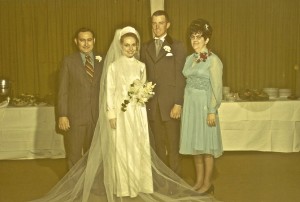
Only someone who has been married nearly 40 years (above) could do it this way.
I will be traveling “solo” on this trip. Carol and I have a loose agreement that she will take one cross-country or international trip per month with me. Those trips usually last from three days to nearly two weeks. She chose the “40th wedding anniversary” trip later this month rather than take the trip to Sri Lanka. If you can get your spouse or significant other to commit to one long vacation every month you are a lucky duck.
I can’t blame her. If all goes well, I will return home to San Clemente for about 24 hours before taking my bride back across country for nearly a week’s celebration in New York City and beyond. When we’re there we will see our UCLA Bruins play the St. John’s Red Storm in Madison Square Garden. We’ll see a couple of Broadway plays and eat some great food.
Of course, that’s if I get back home from Sri Lanka on time! I told Carol that if I don’t make it back home, she could head to New York without me. I won’t tell you her response to that comment.
My plan is to begin traveling back home on February 13, out actual wedding date. How many guys get to do that on their 40th wedding anniversary! I will come screeching up the driveway on Valentine’s Day afternoon, , February 14, if all goes well. If all does not go well, I might try to sneak in the back door.
We’ve been doing it this way all of our lives. My business career required me to be at meetings and/or traveling on many important birthdays, holidays, and anniversaries. Long ago, we decided the rewards that came with that lifestyle were greater than having to be home on any particular day.
We learned to celebrate a birthday on the “nearest clear day”. That has always worked well in the Lewis’ household. Maybe your lifestyle is similar.
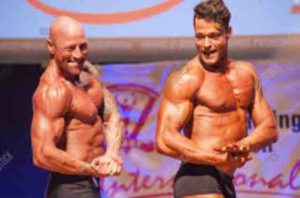
Don’t worry about Carol’s international trackchasing though. She has seen racing in 28 different countries. Only two people have bettered that mark and one of them is me. Heck, when I think about it that way, Carol is one of my fellow competitors. She’s all set to add to those totals later in the year.
THE SUMMARY
Let’s get this party started!
I had a firm race date. The weather was going to be decent. I also had a good way to get to Sri Lanka. The rest was just a process of putting my body through 45 hours of round-trip flying during the 144 hours I planned to be away from home.
I realize this type of travel is not for everyone. Some wouldn’t want to do it. Some wouldn’t want to spend the money it takes to do it. And some might not have the curiosity to put up “with the pain” of doing this. It’s definitely “different strokes for different folks”. Nothing wrong with that.
However, just reading about it will at least get you “down the road” a little bit, even if you never head out the front door bound for a place like Sri Lanka. If that works for you, then it works for me.
Yes, let’s get this party started!
Wednesday – Day 1 – Los Angeles, California to Washington, D.C to Dubai, United Arab Emirates
Up and at ‘em I’m on my way.
Despite all the pre-planning that went into this trip the first two (of six) days would go by fast. Why was that? First of all, I was advancing some 13 ½ hours in time zone changes. Secondly, I was flying eastward at a rate of some 550 M.P.H. for 22 hours. Yes, that makes the days go by fast.
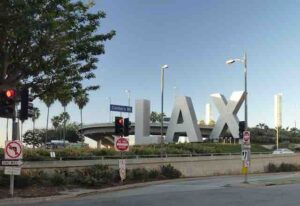
I left home at 5:26 a.m. My flight departed the Los Angeles International Airport at 8:52 a.m. Flying to Washington, D.C. I lost three hours due to the time change. Then I hung out in the Dulles airport in Washington for about five hours.
Finally, at 10:32 p.m. local time I left Washington, D.C. bound for Dubai, a Middle Eastern city in the United Arab Emirates. Early in the 13-hour flight it became Thursday!
Thursday – Day 2 – Dubai, United Arab Emirates to Colombo, Sri Lanka

What happened to Thursday?
The first thing I remember doing today was landing into Dubai at 8:30 p.m. Here I was more than twenty hours into Thursday and the first activity was to land in Dubai! I guess that’s the effect of flying more than 7,000 miles from Washington, D.C. and gaining nine hours in time zone changes.
Friday – Day 3 – Arrival into Colombo, Sri Lanka
I’m still flying.
It was day 3 of this trip and I was still flying! My last of three flights was departing Dubai at the oh so convenient time of 2:45 a.m. This departure had followed a five-hour layover in the Dubai International Airport.
On my return I will have a 12-hour layover in Dubai. That should give me enough time to store my luggage at the airport and take the new metro subway system into Dubai itself. I’ll look forward to that.
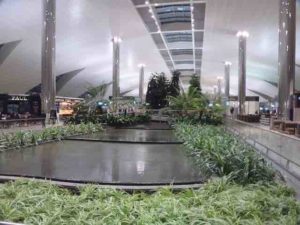
The Dubai International Airport is the fourth biggest in the world for international passenger traffic. Emirates Airlines is headquartered in Dubai and is the airport’s primary airline. Dubai ranks right up there, although a little behind, with the airports in Seoul and Hong Kong. The “new economy” countries seem to have the best airports.
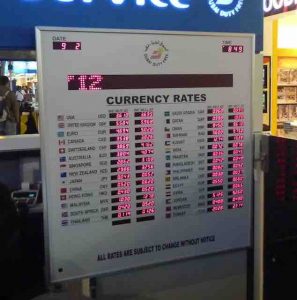
Better get some rupees now rather than risk getting them later.
During my somewhat brief stay in Dubai I exchanged U.S. funds for Sri Lanka rupees. Despite my iPhone telling me the exchange rate was one U.S. dollar for 114.20 rupees, I only received 97.56 rupees per dollar from the money changer in the airport. Why is that? The difference is the “commission” being charged.
First, I charged $200 U.S. worth of rupees to my Visa card. Separately, I turned in $200 U.S. in cash for rupees. This gave me nearly 40,000 rupees and a bundle of bills that barely fit in my jacket pocket. Hopefully, I won’t get mugged and this amount of local currency will cover my trip’s expenses. Anything left over can be re-exchanged, for no fee, when I come back through Dubai.
It’s amazing how busy the Dubai airport is at 2 a.m. in the morning. It’s packed with people of all Middle Eastern nationalities. It’s common to see people wearing burkas. The amount of shopping rivals places like the Hong Kong airport. This is one busy place.
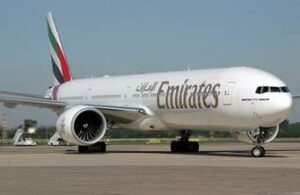
Tonight I was flying Emirates Airlines from Dubai to Colombo, Sri Lanka. Until a couple of weeks ago I didn’t’ even know that Colombo existed. The flying distance is just over 2,000 miles with a flight time of nearly five hours.
Emirates does things right.
Emirates is an outstanding airline. How many other carriers would do this for their passengers on a 2:45 a.m. departure? The entire plane, including coach passengers have three-pronged electrical outlets at each seat. Each passenger was served a hot cloth towel at takeoff. Breakfast was served and included REAL silverware. Small children were each given stuffed animal toys. Each passenger’s seat offered a free auto-visual setup that included several dozen movies. Emirates is an outstanding airline.
I never really like the idea of ‘downsizing’ anything.
I was downsizing my luggage for this trip. Normally, I have a rolling carry-on bag for my clothes. Separately, I’ll have my camera bag and my laptop bag. My sponsoring airlines allow me to take whatever baggage I want at no expense. However, when I actually purchase a ticket I have to be a little more careful with luggage costs.
For this trip I eliminated my laptop bag. I packed as little clothing as I thought the trip would allow. This gave me enough room to stuff my laptop and related cables and cords into my rolling bag. However, when I tried to board the Emirates plane I was pulled over as having a bag too large to take onboard. Fortunately, there would be no charge to check my bag. I took out a few of my valuables, including my laptop, and happily checked my bag. That way I wouldn’t have to mess with it onboard.
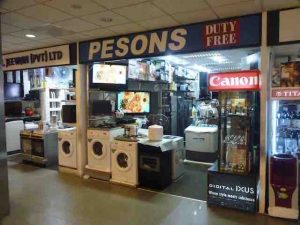
Sri Lanka…at last.
I landed at the Bhandarnaike International airport in Colombo, Sri Lanka at 8:30 a.m on Friday. Time was going to slow down now. I didn’t have any more time zone changes. I had already “advanced myself” some 13 ½ hours getting to Sri Lanka.
For the time being I would not be traveling at 550 M.P.H. I had already done that for 22 hours and covered a flying distance of more than 11,000 miles. I had not gotten much sleep on my airplanes. Nevertheless, it was 8:30 in the morning. I was in Sri Lanka. Now all of the planning I had put into this trip was going to be put to the test.
The real fun of coming to Sri Lanka was about to unfold. I had 72 hours to see and do all I could culminating on Sunday with seeing some auto racing in my 57th different country.
When those 72 hours had passed, I would begin to “stop” time not advance it. I would “re-gain” those 13 ½ hours I had lost. I would be flying more than 11,000 miles backwards in you will. If all went well I would be back home for Valentine’s Day. I would have 24 hours in San Clemente and then “Trackchasing’s First Mother” and I would fly 3,000 miles back east to New York City. There we would celebrate our 40th wedding anniversary. When that celebration ended I would have traveled overnight for eleven of the past twelve nights. I would have flown nearly 29,000 miles in those twelve days.
I had never seen this before.
But, hey, let’s not put the cart before the horse. I’m in Sri Lanka now. I want to enjoy my three days here.
The airport was small and on the older side. Like almost all international airports it had a huge duty free store. However, the Bhandarnaike International Airport had something I had never seen at least in this quantity before. Out of the 10-12 stores in the airport at least eight of them were solely devoted to selling home appliances. That’s right! Store after store of small clothes washers, home refrigerators and the like. It was unbelievable!
What do I do now?
I had landed in this faraway country without any hotel reservations for the first two nights or firm ground transportation plans. Would you do that? Should I have done that? Per the recommendation from my Sri Lankan TripAdvisor friends I was going to arrange all of this AFTER I landed.
They told me you would have to be nuts to drive in Sri Lanka (they were right!)
I retrieved my last minute checked bag and began to look around. I had been told it might be about $60 U.S. per day to hire a driver. I had also been told it would be absolutely crazy to try to drive on my own. This was going to be my 12th Asian trackchasing country visit. I had only rented a car in Bahrain and Qatar. For the most part I was quite happy to NOT have rented a car in the other Asian countries!
I would need a driver for all or parts of four days. I figured that should cost me somewhere between $180-240 U.S. The first place I stopped wanted $300 U.S. I challenged the price and they agreed to lower their offer to $250 U.S. I told them I would get back to them.
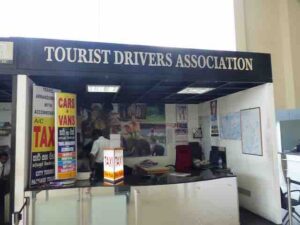
The TDA rocks.
The next place was called the ”Tourist Drivers Association”. The folks here seemed much more personable and asked me to come in a take a seat. The manager, Anura, spoke English well and honestly convinced me he was working in my best interests. Carol’s says a salesman will buy anything from another salesman! I think she’s right.
What did I want to do?
Anura had me explain exactly where I wanted to go and what I wanted to see. This was important so he could price out the mileage of the trip for his driver. He also had some ideas on where I could stay for the two nights (tonight and tomorrow) where I needed a hotel room.
After some minor negotiations we had an agreement. For $270 U.S. I would have a driver from Friday morning until it was time to be dropped off at the airport on Monday morning. Anura also could get me into a “very clean” guesthouse where I could stay for two nights. Breakfast would be included. The price seemed more than fair and the operator seemed sincere. I peeled off some $30,834 Sir Lankan rupees and I was paid in full.
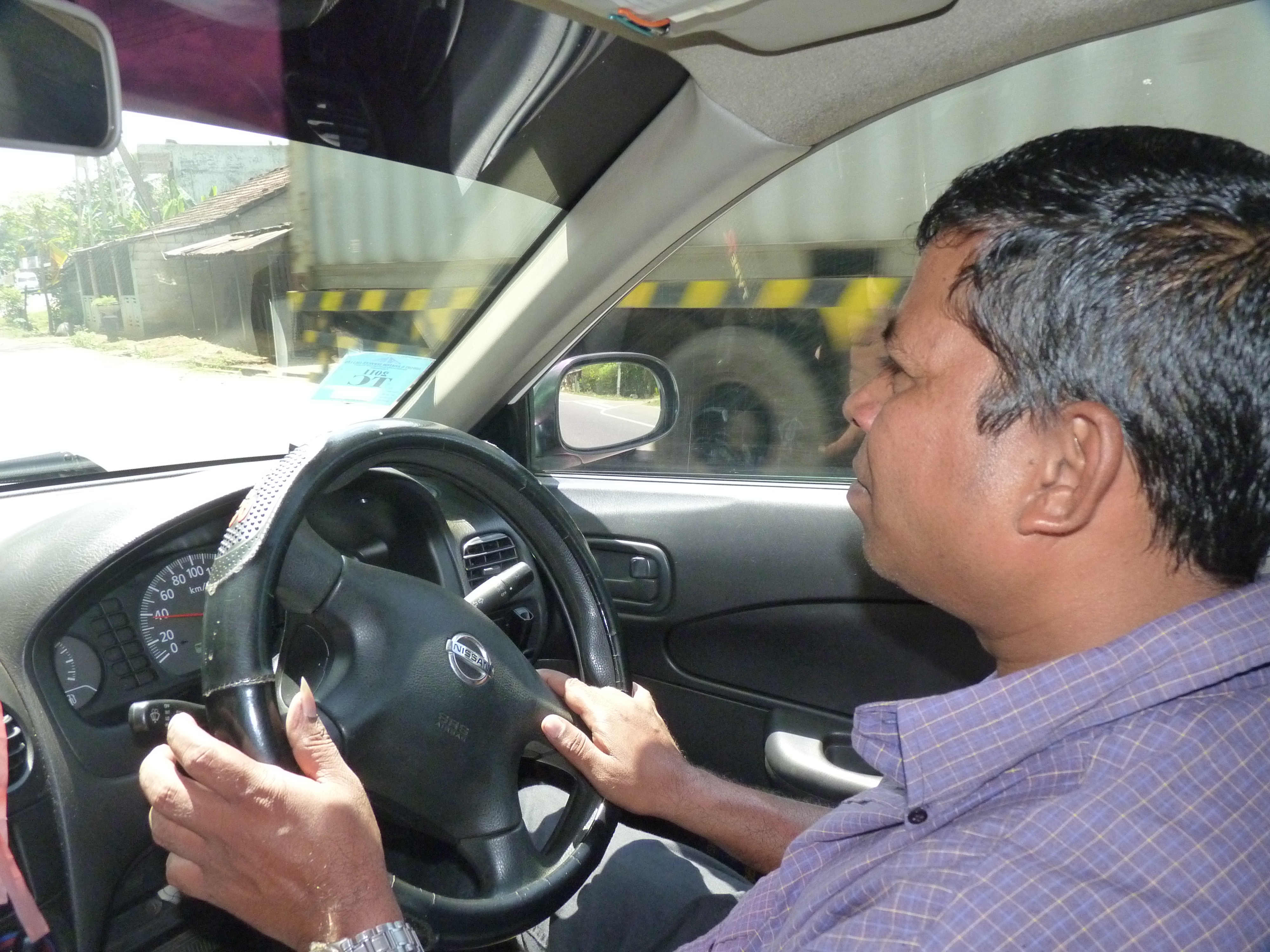
Let’s meet Ariya, the ‘Quarterman’.
Next up Anura walked me outside the airport to meet the “Quarterman”. Quarterman aka “Ariya” was nicknamed for his short stature. He stood all of about five feet tall and was 42 years old. Ariya would be my driver for the next four days. We would travel in his Nissan station wagon. As promised it had air-conditioning.
Oh my! That’s all I can say is ‘Oh my’.
Next up I was about to get an indoctrination into Sri Lankan driving. Oh my! Could I have driven in Sri Lanka? Yes, I could have. Would I have driven like Ariya did? No, I would not have.
It wasn’t that Ariya was a bad driver. He wasn’t. It’s just that he was an “aggressively controlled” driver. The entire scene was like an “E-ticket” (do people still say that anymore?) ride in a video arcade with shocking electrodes tied to your head that went off anytime you thought you were going to die. Those imaginary electrodes went off frequently.
There are a myriad of machines and people using the “highways” of Sri Lanka. There were old trucks that were grossly underpowered for the weight they were carrying. Most of them belched black diesel exhaust into the air. There were public and private buses of all sorts and sizes. There were stray dogs. There were more taxi drivers and private vehicles. There were tons of people walking along side the roads. There were folks on bicycles. And then there were “Tuk Tuks”.
Don’t know what a “Tuk Tuk” is? Click on this link to see what one looks like (Show me a Tuk Tuk). These are essentially three wheel motorcycles with a small shell around them to house the driver and 2-3 passengers who would sit on a bench seat behind the driver. They are slow and like the trucks and buses underpowered.
The streets are almost all two-lane and narrow. The whole scene reminded me of a fish aquarium. I’m sure you’ve seen these where several species of fish swim in all different directions at various speeds….and they never run into each other. That is what happens with the Sri Lankan traffic situation. Everything and everybody goes in their own direction at their own speed and nothing seems to run into the next species.
Is Ariya rewarded for passing points?
It really is mind boggling to see such a wide variety of activity on streets like these. The driving strategy for “Ariya” is simple. He operates on the theory of “passing points”. I think he wants to pass every person, vehicle or Tuk Tuk that he can see. He is very successful with this strategy….so far. Even though our Nissan is very much underpowered few people seem to pass us.
I, on the other hand, have worn out two pairs of tennis shoes trying to “brake” from my passenger’s seat on the left side of the car. Ariya seems to get the biggest kick out of it when I slam on my “imaginary” brake AND put both hands on the dashboard in a white knuckle grip. He just laughs and laughs. Ariya’s car is right side steer and they drive on the left side of the road in this country. That comes from Sri Lanka being a British colony many years ago.
Folks, I will try to capture this driving experience on video if I can. That’s assuming I can keep my hands steady from both fear and rough roads. Every time I get back in the car I start to get sick from anxiety. Is country #57 really worth this?

I wanted an English speaking driver.
I had asked for an English-speaking driver. Ariya barely meets this requirement. There will be no in-depth conversations like I had with my best ever driver, Ruswadi, in Indonesia. However, Ariya is a nice and thoughtful guy and will do anything I ask if he understands what I want.
To begin with we stopped for petrol. The cost of petrol is included in my “all-inclusive” price. In Sri Lanka one liter of fuel sells for 137.10 rupees or about $1.20 U.S. That makes a gallon of fuel at about $4.50 U.S. Sri Lankan fuel is around a dollar a gallon higher than current U.S. prices.
It was time for lunch.
A bit later I told Ariya I would like to stop for lunch. So far I have seen ZERO “Western” retail food brands. Frankly, given the landscape I don’t expect to see any during the entire trip.
Ariya soon turned into a place that he recommended. This was going to be a wall less building that was serving a Sri Lankan buffet. It might not have been my first choice but there weren’t any other nearby alternatives.
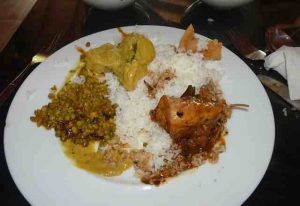
I had been advised that “curry and rice” would be found nearly everywhere. These folks had curry and rice. They also had a few other things that I didn’t recognise. I took a little bit of most of them. Then I asked if they had any chicken to go with it. Of course they did.
Soon I was chowing down in the heavy duty heat and humidity of Sri Lanka on some pretty tasty but HEAVILY spiced local food. Don’t worry, I love spicy food. The food was so hot it made my bald spot itch and I don’t even have a bald spot. However, I was soon going back for seconds on everything. Ariya was served a plate of pastries but he didn’t eat much. I had been advised to avoid drinking the tap water. I would end up drinking a lot of bottled water, diet soda and beer.
I had no idea what this meal was going to cost. Internally, I guessed on the high side. When I got the bill I was shocked. It came to 90 rupees. That’s about 79 cents. Talk about the “dollar menu”. I generously (?) left another 10 rupees tip and we were off.
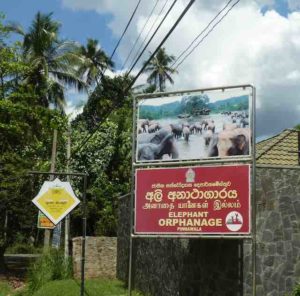
This stop came highly recommended.
Our first stop would be the “elephant orphanage” (Let me see those elephants). This had been highly recommended by my TripAdvisor friends. Getting there took us nearly three hours. It was three hours of fun sightseeing with close-up views of the daily Sri Lankan lifestyle. The drive was also filled with agony each time my “life passed before me”. I learned that when an oncoming driver put his lights on at the last minute that was a bad sign, a real bad sign.
Twenty for you and one for me.
My Sri Lankan lunch had been a great deal. Buying a ticket to the elephant orphanage less so. The elephant orphanage has a “foreign ticket” booth and one for locals. Foreigners pay 2,000 rupees (about $17.50 U.S.) and locals can get a ticket for about 5% of that total. Oh well. I know. It reminds me of the U.S. tax system. You win some and lose some.
It was Friday afternoon. I was sweating like crazy in the heat and humidity. I was still wearing the clothes I put on Wednesday morning when I left San Clemente. That was 11,000 miles ago. I needed an oil change and a change of clothing.
Please don’t miss the pictures and film of the elephants. This will be a highlight of the trip. For a 100 rupee tip I even got to stand next to one of the elephants so I could pet him. Ariya captured this using my iPhone video. However, he apparently doesn’t have the Apple “Customer Care” training program and is still learning his “iPhone way”.
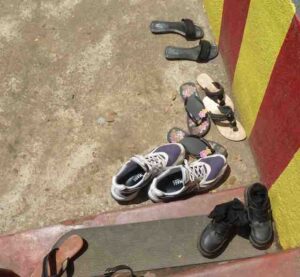
Next, the first of several Buddhist temple visits.
Along the way we stopped at a Buddhist temple. There I learned two things. You have to take your shoes off to enter a temple. Most of the shoes at the door could be put inside my Reebok “long boats”. There are no Sri Lankans with size 13 shoes. Secondly, you’re not supposed to take pictures inside these shrines. Now I know.
It was time to be “walked”.
Next up was something I didn’t ask for or really want. Ariya pulled the car over and asked me if I wanted to get a massage. I told him that really wasn’t at the top of my list especially in this heat. He insisted that this would be a good idea and it was “free”.
I soon learned I was being “walked”. The TripAdvisor people had warned that driver/guides will take their clients to places where they could get a commission off of any sales generated. It wasn’t long before one of the locals was taking me through an isolated forest. There were several times during this trip where I wondered if I was entering a “set-up”. Every so often we would stop in the jungle and my guide would explain the healthful properties of the vanilla plant or the cocoa plant or whatever. At the end of the “session” I was offered tea and a massage from a young man. No thanks. I only get massages from women! That’s the way I roll.
Let me be clear. Often, during the trip, Ariya stopped at places that I never would have considered stopping at that were wonderful. I don’t know what financial arrangement that Ariya did or did not have with any of the stop’s proprietors. With the exception of the “massage parlor” everywhere Ariya wanted to stop was a great idea.

It was time to do some ‘splaining’.
Once back in the car I tried to explain to Ariya that I didn’t want this type of thing to happen anymore. “You didn’t like the massage?” he asked. “Ariya, I don’t want any massages”, I told him as firmly as I could. Did he understand? Probably, but I don’t know for sure.
My home away from home.
A little bit later we were arriving into the hillside town of Kandy (Learn more about Kandy). I was in luck. Ariya had grown up in Kandy. My guesthouse would be in Kandy. Ariya had a little bit of trouble finding the “Ivy Banks Exclusive Tourist Guest House”. That’s because it’s about as off the beaten path while still being in the city as it could be. I think the Sri Lankan translation for the word “exclusive” is remote.
We passed through a 100% dark tunnel some 200 yards in length. Inside that tunnel were pedestrians and a good deal of vehicular traffic. This was a very narrow tunnel. It was not wide enough for two vehicles and pedestrians to pass at the same time. I wasn’t sure why Ariya didn’t turn his lights on. Maybe it just added to the challenge of missing the walkers.
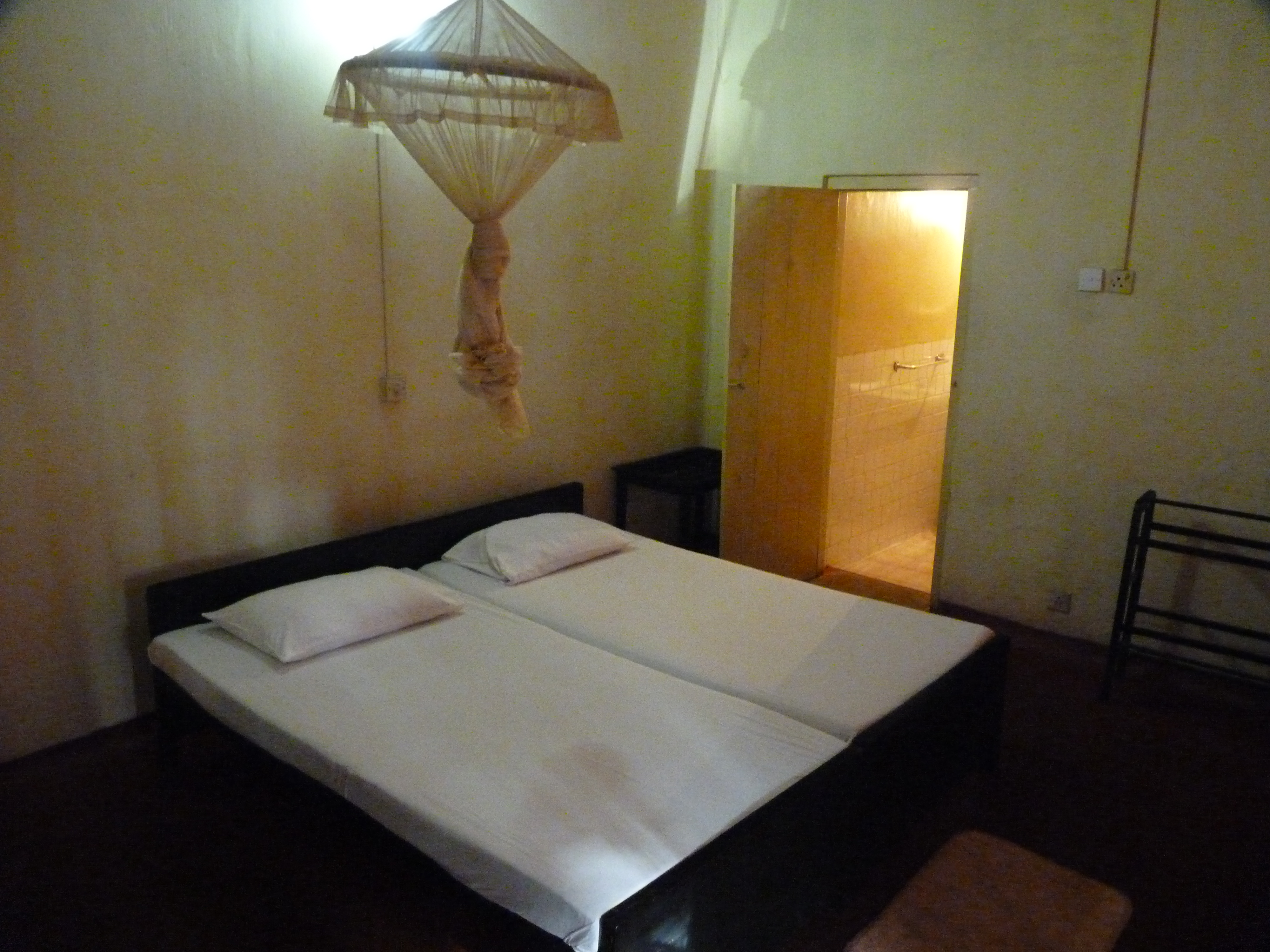
I couldn’t beat the price and they told me I didn’t need air-conditioning.
My overnight accommodations had been “priced out” at $27 per night including breakfast inside my all inclusive price of $270 for my transportation and lodging. I had requested air-conditioning. However, I was told Kandy is at “an elevation”. You don’t need air-conditioning and the view is fantastic.
The Ivy Banks is, how shall I say it, secluded. My room is large and old. It probably measures 15’ by 15’ with ten foot ceilings. The room has three twin beds. There’s no phone or TV. The place is not new. None of the electrical plugs will accept my “universal” power adapter. That’s how “not new” the guest house was. I’ll have to use Ariya’s power adapter in his Nissan to keep things charged.
One of the best things about my room was that it had a huge ceiling fan. The fan had six speeds. The low speed barely made one revolution per minute. However, the top speed pretty much replicated the blades of a Bell helicopter. It cooled off some in the evenings here and I did not need air-conditioning.

My room included a bathroom. It’s basic and old. Luckily, it has a shower. That’s going to feel good. I had not slept in a bed for the past 48 hours. After we checked in at 4 p.m., I told Ariya I needed a one-hour nap and then we would be off for the evening.
When tourists hire drivers the hotel where the tourist stays is expected to have some form of “accommodation”. This accommodation is normally free. I was lucky. Ariya would be staying with one of his sisters who lived nearby, also in the city of Kandy.
After my nap, it was time to go clubbing…sort of.
My touring activity for the evening would be the Kandyan dance show (See the reviews). These Sri Lankan native dances were performed indoors at a theatre adjacent to Kandy Lake. We arrived just at the starting time. Ariya “made a parking spot” for us and soon I was enjoying this cultural experience.
I had wondered where all the white people were in Sri Lanka. They were inside this theatre! This was definitely a “tour bus” stop. It wasn’t my favorite Sri Lanka touring activity but if you’re here and you have the time you might as well see it.

Following the performance I had a hankering for Chinese food. I told Ariya what I had in mind. In less than five minutes we pulled up in from of an old building housing a Chinese restaurant. It had a commanding view of Kandy Lake and was just what the doctor ordered.
Having my own private driver who knows the area so well is perfect. The expense isn’t much and the itinerary is 100% customized. What’s not to like about that?
It wasn’t long before Ariya was dropping me off at my guest lodge. Did I tell you the place was complete with a huge mosquito net for each of the beds? I didn’t use ‘em but I did when J.J. and I traveled to South Africa. I had been warned about the mosquitos in Sri Lanka. They never turned out to be a problem for me.
TODAY’S HEADLINES
My best idea of the trip ……..details in “Saturday – Day 4”.
How many people get to do this? …..details in “Saturday – Day 4”.
Miscellaneous observations………..details in “Saturday – Day 4”
It pays to know people and Ariya gets promoted ………..details in “Sunday – Day 5”
Saturday – Day 4 – Kandy, Sri Lanka
My best idea of the trip.
Did I mention that you would have to be a stark racing maniac to drive in Sri Lanka? If you weren’t to begin with you would be within thirty minutes. The smartest thing I did on this trip was to hire a driver.
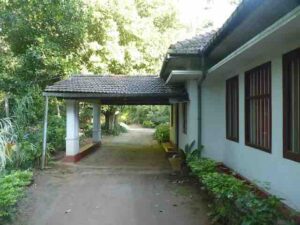
Why didn’t Osama Bin Laden stay here?
The day started out peacefully with breakfast at my hotel. I believe I am the only hotel guest. If Osama Bin Laden had stayed at the Ivy Banks Exclusive Tourist Guest House the Navy Seals never would have found him. The place is that remote. The last half mile is straight up an unpaved rocky one-lane road.
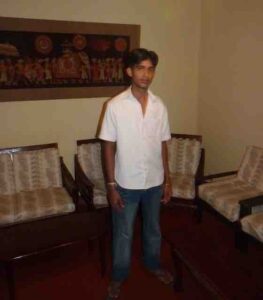
My guest house breakfast was just right. It was prepared by my house boy. The table was set with six pieces of crisp white toast accompanied by fresh butter and jelly. Although I was offered both coffee and tea I declined. I was served an “Orange Julius” type drink which was delicious. This was followed by a ham and egg omelet. How could I go wrong at twenty-seven dollars for this bed and breakfast guest house?
Today touring; tomorrow racing.
I’m only in Sri Lanka for two full days and two partial days. Today is my “full touring” day. Tomorrow is “race day” although the racing should be wrapped up by 1 p.m. or so.

My first stop was one of my best.
Today’s schedule will be full. The day’s first outdoor activity would be Ariya’s picking me up at 8 a.m. From my guest house we headed toward the Royal Botanical Gardens of Sri Lanka (Botanical Gardens).
I had wasted some money with poor strategic thinking.
On the way we made a quick stop at an ATM. I made a mistake exchanging money with the money broker in the Dubai airport. My iPhone “currency” app tells me one U.S. dollar should buy 114.2 Sri Lankan Rupees. However, the airport money broker only gave me 97.56 rupees for a single U.S. dollar. That’s about a 15% commission. Of course, 15% of the $400 U.S. I exchanged comes to about $60 U.S.
A smarter move would have been to exchange, in advance, only a small amount of U.S. funds, maybe twenty dollars. However, I had no way of knowing the Tourist Drivers Association would give me the FULL exchange rate. You win some; you lose some. In the future I think I will exchange less many in advance.
I would not classify myself at a “botanical gardens kind of guy”. However, the TripAdvisor folks had recommended a stop here. I have a lot of faith in TripAdvisor. I’m glad I went with their recommendation.
At 9 a.m. when I approached the ticket window. It was still mostly cool from what the afternoon heat would bring. The admission price to the gardens for “foreign visitors” was 1,100 rupees. Locals could get in for just 50 rupees. That’s a big difference but it sure helps out the residents of Sri Lanka. I don’t have a problem with this policy. It’s sort of like the U.S. income tax system. The top 5% of the population pay 60% of the taxes and the bottom 50% of the population don’t pay a thing!

Stunning!
The botanical gardens were stunning on a cooler and very bright Saturday morning. You won’t want to miss the pictures if you’re into the “flora and fauna” of life. My first stop was at the orchid house where I snapped several photos for orchid expert and golfing buddy Tom Lindell.
For my next act, I ended up walking over a 367-foot suspension bridge. That’s longer than a football field. When I reached the middle, along with a park employee, we saw a crockadile swimming down the Mahaweli River. He told me they were “pretty tame”.
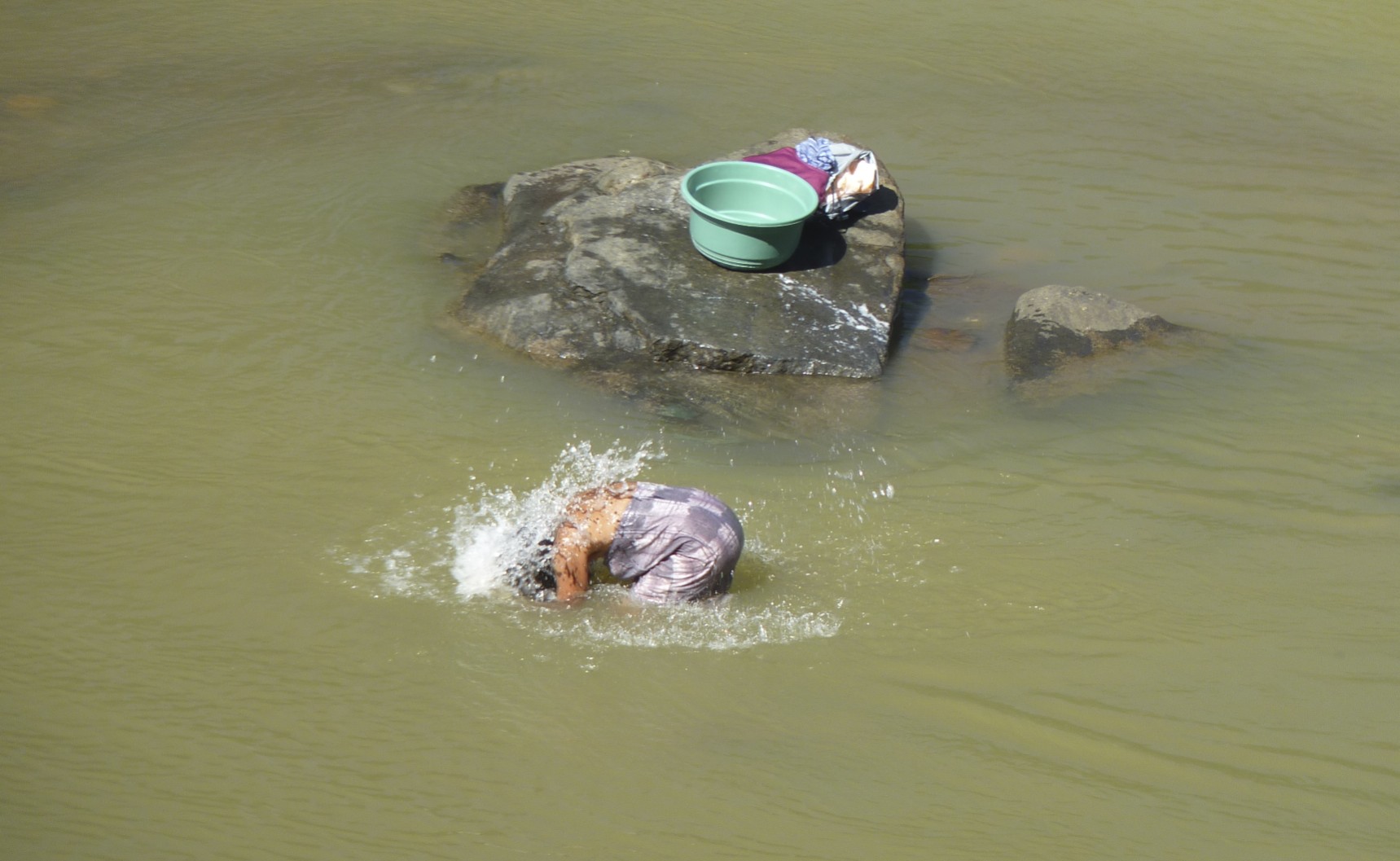
No I’m not a ‘peeping Tom’….I don’t think.
During my stay in the botanical gardens I walked past the river and observed from a high vantage point. Several local women were taking their bathes, fully clothed of course. They were shampooing their hair just as if they were in the shower at the Westin. Don’t miss the pictures.
I spent nearly two hours on my own in the gardens. For the most part, Ariya leaves me to my own devices at our tour stops. I like it that way.
The main “temple stop” was to be the “Temple of the Tooth”. More on that later. We did stop at two other temples where local guides explained their 14th century histories. Again, don’t miss the photos. There was one drawback to these tours. To enter the temple one must remove their shoes. Walking in my socks over uneven granite stone on a warm day is hard on the tootsies.
I was getting hungry.
By just past noon, it seemed like it should be about time for lunch. The major advantage of having your own driver compared to being part of a scheduled tour group is YOU get to direct the location and timing of the stops. You decide when and where to stop for lunch. I like that.
Ariya often doesn’t seem to understand my English or speak much of it on his own. That’s O.K. At times I like the piece and quiet of just watching the landscape roll past. When Ariya stopped at yet another Buddhist Temple I waved it off. “It’s time for lunch” I told him.
Ariya had two more stops planned before lunch. First he wanted to take me to a “Batik” shop. Coming into this trip I didn’t know the first thing about batik. It turned out that Aryi’s distant relative owned this batik shop. The average Sri Lankan might be 5’4” and about 120 pounds. Their idea of an XL shirt is not what I wear. They didn’t have anything that would fit me.
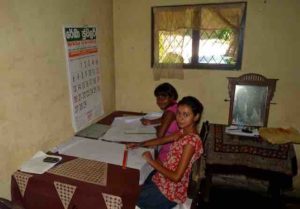
How many people get to do this?
The final stop before lunch would be at Ariya’s sister’s house. He told me she ran a “small batik factory” that he wanted me to see. I must be honest with you. At this point I was getting hungry and really didn’t want to stop to see any more batik. Ariya was insistent so I went along. I’m glad I did.
I could imagine the “hard sell” coming. However, as my mother used to say on more that one occasion, “You deserve twenty lashes with a wet noodle” for that line of thinking. There was no hard sell. The experience was exactly the opposite.
We did tour the “factory”. It was a small room of about 12’ by 12’. We arrived here by driving into a residential neighborhood. If you think “residential neighborhood” means anything like YOUR residential neighborhood forget it. The last one hundred yards was similar to the way to my guest house. The road was unpaved, one-lane and straight down hill. We inched down the road at a snail’s pace to avoid driving over the side. Inside the building one woman was painting colors on a future wall hanging. Two young girls were doing the drawing of the designs that would be “painted in” later in the process.
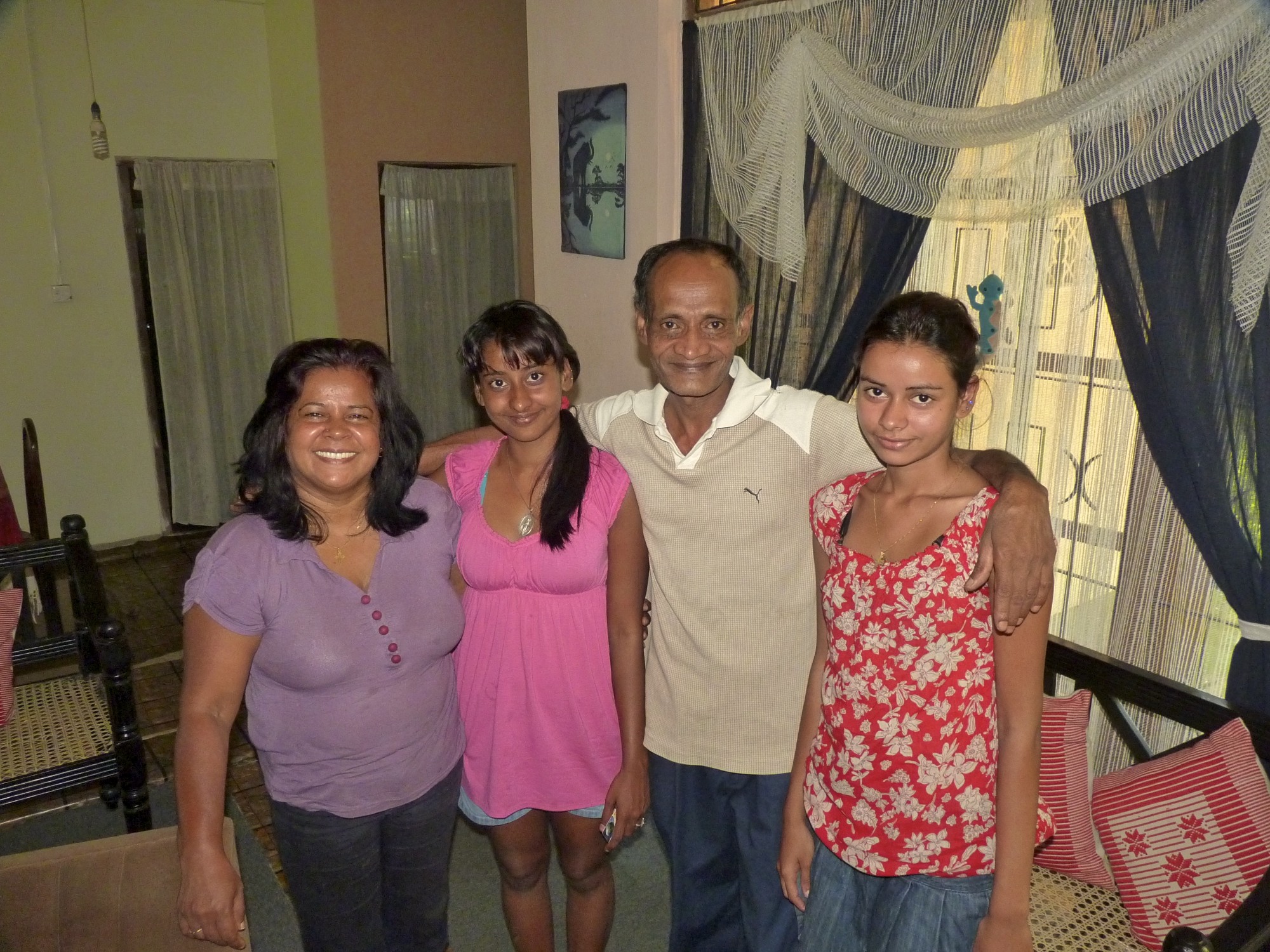
This was the #1 highlight of my trip.
From there I was invited inside the home of Ariya’s sister, Chandra. It was a pleasant home of the Sri Lankan middle class family. His sister and her husband, Lalith, were more than happy to have a guest. Sadly, I kept waiting for someone to jump out and try to sell me “twenty batik wall-hangings for the price of fifteen”. I guess I have become too jaded for my own good.
Ariya’s sister did not speak much English. However, his brother-in-law was a good English speaker. While we sat in their living room, they invited me to have “tea”. Folks, I am not a “tea person”. I don’t really care for the taste of it. I’ve probably never had a full cup or glass of tea in my life. However, when you are a guest you’ve got to be a good guest.
I asked for my tea to be served with a good bit of milk and a good amount of sugar. That way it hardly tasted like tea at all to me! My tea was served with a fresh tin of assorted cookies. I was hungry. I wanted to eat about twenty of those cookies but that wouldn’t be very “questlike”. While I was enjoying my treat the families’ two daughters, Ashini and Shehani, came up from their work position in the “factory”. When I had first met them they had seemed much younger than their correct ages of twenty-one and nineteen.
The young ladies were both very pretty, engaging and just like young girls of that age. The oldest, Ashini, had been a gymnastic star in high school. Her medals adorned the family’s living room. She was most proud of a silver medal earned at a meet in India.
I was making myself at home.
All the while I’m drinking tea and eating cookies, I’m carrying on a conversation with several Sri Lankan people in the comfort of their own home. How many people get to do such a thing? This trackchasing hobby really is pretty cool.
I asked the girls what their aspirations might be. Although they didn’t have a firm plan Shehani was leaning toward being a dance teacher and Ashini wanted to get involved in the hotel and tourism business. Of course, I had to ask them if they had any boyfriends. This elicited the requisite giggles. I think they enjoyed talking to an American and I very much liked my time speaking with them.
Shehani was even featured in a video on YouTube. You won’t want to miss this music video. Carol loves it. To see it click on the link below.
Folks, it really is about the chase and not the race.
I know that not everyone “understands” my attraction to trackchasing. Folks, “It’s about the chase not the race”. Even if you don’t understand or appreciate the idea of trackchasing I think you might have to admit I do get to experience more than just about anyone you know, right? The next feature should support that point.
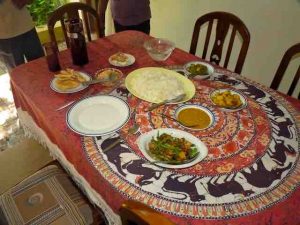
What’s for lunch?
As tea was wrapping up Chandra, Ariya’s sister, asked if I might like to stay for lunch. As a good guest I could not turn down such an offer. I was told to sit tight and authentic Sri Lankan food would be coming my way. I didn’t want to put anyone out but I could tell they really enjoyed having a guest in their home and wanted to give me the royal treatment.
The story of the Sri Lanka working class.
This gave me plenty of time to speak to Aryi’s brother-in-law, Lalith. He’s 57 years old and works as a factory manager in a ball point pen factory. He leaves his home each week by catching a bus at 4 a.m. for a four-hour ride into Colombo. He actually has a room in the factory where he stays all week until he returns home usually on Saturday.
This is an assembly plant. It’s owned by his sister’s son. They get their materials from India, put the pieces together in Sri Lanka and sell to an area in and around Colombo. Most of the 100 plant workers are women. They work 12 hours shifts five days a week and earn about 20,000 rupees (about $200 U.S.) per month. Next time you’re mad at the boss and you don’t think the company is valuing you quite enough you might like to compare your situation to others in this small world of ours.
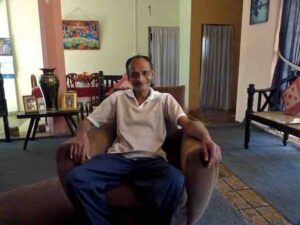
Lalith seemed to enjoy answering my questions. I’ve found that people like to talk. The best way to get them to talk? Just ask them questions! Pretty simple, huh.
He told me that with Sri Lankan health care patients, often times have to wait to get an operation or some other service. There is no social security in Sri Lanka, only government workers get a pension. We talked about the traffic problem in the country. I told him I was surprised I had not seen any accidents up to this point. He assured me there was frequent bad accidents often with pedestrians walking along the roadside.
We were having lunch….no I was having lunch.
By this time lunch was being served. Let me be more specific. Lunch was being served for ME only. Chandra, Ariya’s sister, had come up with TEN separate dishes for me to sample. This included rice, vegetable soup, chicken, several dishes I didn’t recognise as well as Dahl (somewhat like corn) and a deviled eggs equivalent. As Charlie Garrett an old golfing pal used to say, “It was all mighty good”.
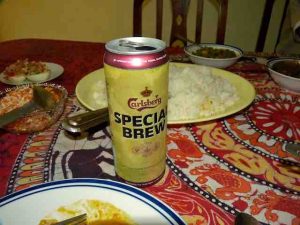
While I was having so many choices served to me, my driver Ariya was served a plate from the kitchen. He proceeded to eat his lunch of rice and the fixins with his hands only. I had seen Indians in Singapore do this. I stuck with the traditional knife and fork. To top off my meal they served me a tall can of “special brew” Carlsberg Beer.
When lunch was finished we chatted some more. I had many, many questions about Sri Lanka and the Sri Lankan way of life. Everyone patiently gave me their point of view. Then it was time to go. There were the hugs and handshakes as if we had all known each other for a very long time. Ariya’s face was beaming. He had been able to show off his beautiful family. My face was beaming too. A year from now and for a much longer time the highlight of this trip will likely not be the Sri Lankan race I will see tomorrow. It will be today and the afternoon I spent in the home of a very real and a very friendly family from Sri Lanka.
Nap time.
From here it was back to the hotel for my one-hour late afternoon nap. Remember, Sri Lanka is 13 ½ hours ahead of my time zone in California. Following “nap time” it was off for some evening “temple touring”.
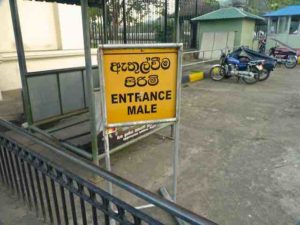
Temple of the Tooth, don’t miss it.
Yes, I had toured temples in the afternoon. However, the really BIG temple tour in Sri Lanka, and the city of Kandy in particular, is the “Temple of the Tooth” (Temple of the Tooth). There isn’t space to go into the history of the Temple of the Tooth here. I will say this, each evening at 6:30 p.m., there is a big Buddhist celebration. Worshipers file past of the huge golden “tomb” where the mid-evil Buddhist emperor’s tooth is kept. The tooth is actually in about seven tomb like casings and is only displayed to the public every several years. Unfortunately, photos of the golden outer tomb were not allowed.
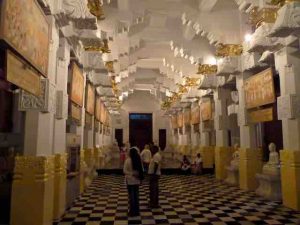
Following this very worthwhile tour stop, I returned to the car where Ariya was faithfully on the lookout for me. It was dark now. When we got in the car, Aryi’s first question was, “Where are you going to have dinner?” Truth be told after such a huge lunch I didn’t need any dinner at all.
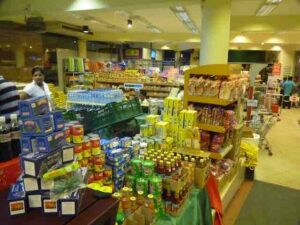
Take me to Ralphs.
I instructed Aryi to take me to a grocery store. I love touring grocery stores in foreign lands since I spent so much time in them during my business career. Once inside I purchased a large bottle of water, a can of Diet Pepsi and a very small serving of vanilla ice cream. My bill came to less than two dollars and I received my first Sri Lankan coin as change. All was good and soon we were back at my hotel.
Dumbness is often wasted on youth.
This was not before we saw two youths trying to jump start their motorcycle with a cord tied into their home’s outdoor lighting system. This, as they probably didn’t expect, generated a huge explosion. It did start their motorcycle but the smell of burnt wires and the sight of the exploding outdoor house light was with us until we arrived at the Ivy Banks Exclusive Tourist Guest House. A good time was had by all today.
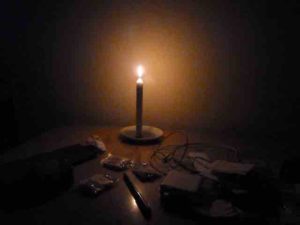
Miscellaneous observations. They do it differently here.
The electricity seems to go off frequently in Sri Lanka. After one such episode in my guest house tonight one of the employee’s arrived at the door of my room with a tall lit candle.
People in foreign countries seem to eat their meals much later than we do at home. In San Clemente, breakfast is served at about 7 a.m. Lunch comes in shortly after noon and then dinner is served at 5:30 p.m. Heck, my grandparents always had dinner at 4:30 p.m. when the Cat factory day shift ended at 3:30 p.m. I was told by Ariya’s brother-in-law that they eat dinner sometime between 8-10 p.m.
Pedestrians don’t seem the least bit fazed that every motorized vehicle roars past them within six inches of disaster. To use a racing term, they “don’t change their line”. If they did they would be dead. The walkers seem oblivious to this impending danger. I am sure the personal liability laws in Sri Lanka are nearly non-existent.
The material side of the Sri Lankan lifestyle is on the low side of the continuum. Growing up in a lower class economical neighborhood I can relate to some degree. We didn’t have much in the way of material things. However, because we had never known many of life’s luxuries we didn’t “know what we were missing”. That seems to be true with Sri Lankans and most people of lessor means. I suspect that if they were used to having air-conditioning, a big-screen TV, a brand new car and on and on and then didn’t…..there would be more riots across the world than there are now. About the only middle eastern country that has not seen any of these civil disturbances is Qatar. There people pay no taxes, get free electricity and health care and hold high-paying steady jobs all given out by the government. It’s rare that you see a strong middle-class doing much rioting.
Folks working at the tourist attractions all offer a friendly attitude. However, it can’t be forgotten that they are working for money. If you forget to tip or don’t tip enough they will mention it discreetly or directly. More power to them.
Despite the aggressive attitude of most Sri Lankan motor vehicle drivers, nobody seems to get bent out of shape. I see no expressions of anger from pedestrians when someone goes honking past and nearly kills them. Drivers of vehicles simply cut in line, normally without so much as a wave, and the affected driver doesn’t seem to have any reaction at all.
I noticed that many people don’t seem to “respect the queue” all that much. Folks, just kind of “move in” when they can. I’ll bet no Sri Lankans have ever, successfully, tried that at the Orange County Fairgrounds Speedway!
I think Sri Lanka has a good idea with their tourist activity pricing. Foreigners pay about twenty (20) times what a local pays for the major tourist attractions. The price for foreigners is still “within the ballpark” and locals get in for just about free. As a foreign visitor I’m not going to NOT come to Sri Lanka because they charge $10-20 U.S. for admission to their prize attractions. Heck, Disneyland costs about $100 a day.
Sunday – Day 5 – Pannala, Sri Lanka
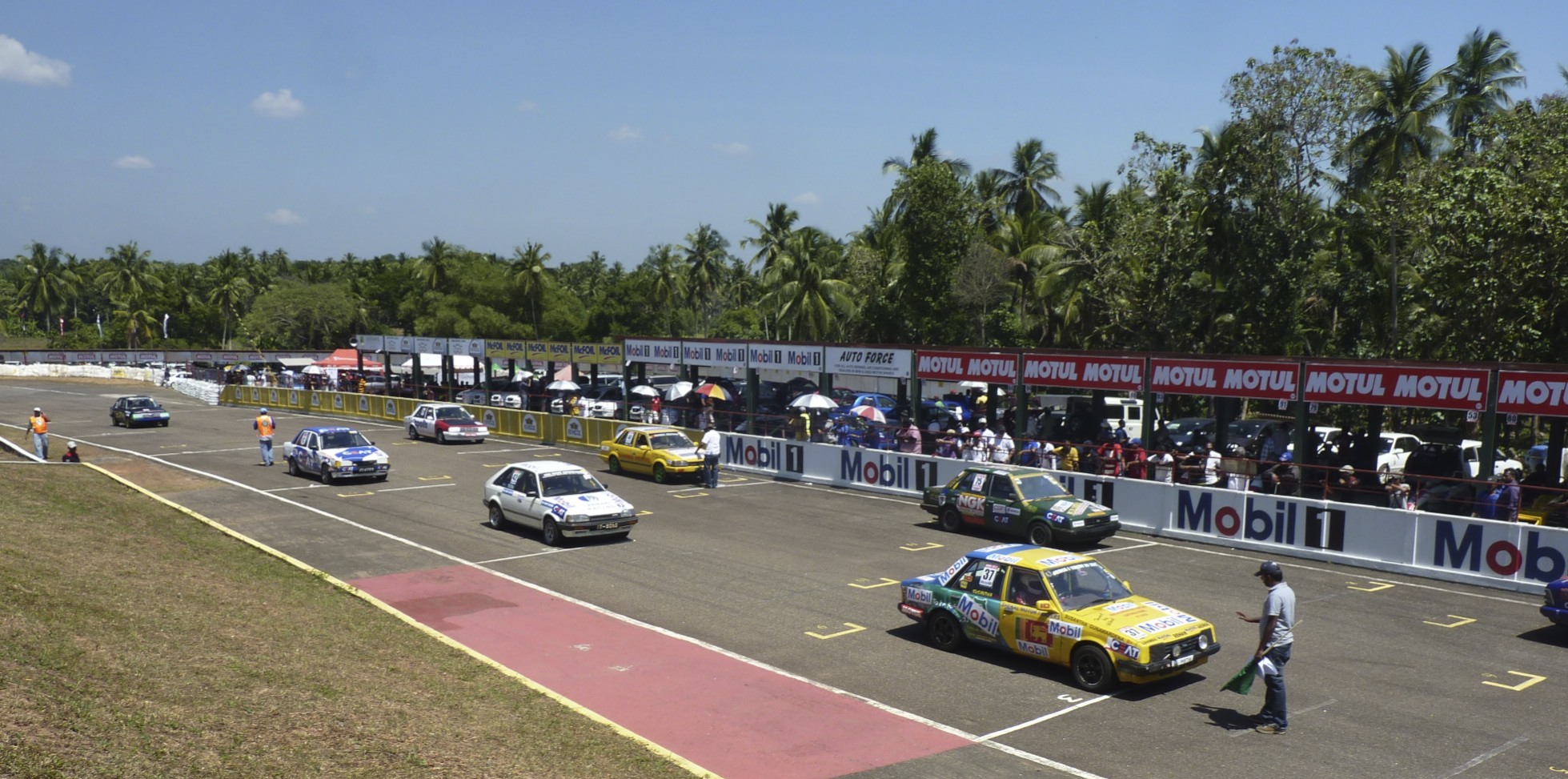
Seeing a new track that’s also in a new country for me is somewhat rare.
Today is race day in a foreign country where I will see racing for the first time. In some 1,732 first-time track visits I have only been able to say that 57 times. That makes it a pretty rare occurrence. However, my international visits are not as rare as those of Ed Esser. Ed has seen the second highest number of tracks on anyone in the world with more than 1,400. However, he has NEVER seen a track outside of the U.S.
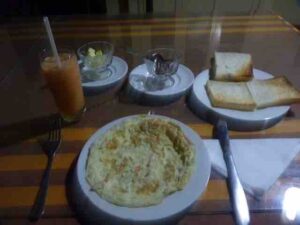
My day began at 6 a.m. with breakfast at the Ivy Banks Exclusive Tourist Guest House. This wasn’t the worst place I’ve ever stayed and it was far from the best place I had overnighted either. Last night the Sri Lankan serving boy wasn’t thrilled when I had requested to take breakfast at 6 a.m. then morning. When I entered the breakfast room at the appointed time today everything was dark. However, my server was soon roused from his sleep and made breakfast quickly. Ariya, my driver showed up on time at 6:30 a.m. and we were headed to Pannala, Sri Lanka home to the Pannala Race Track.
We were now in the part of the day I least looked forward too. Driving on the Sri Lankan highways. I maintain these people are absolutely CRAZY. However, knock on wood, we didn’t come across an accident during the entire trip.
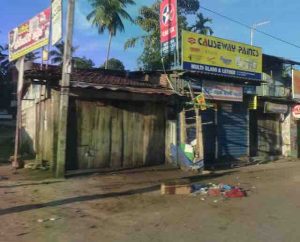
The U.S. state department has this to say about driving and road conditions in Sri Lanka, “Narrow two-lane highways, overloaded trucks, poorly driven buses, and a variety of conveyances on the road, ranging from ox carts and bicycles to new four-wheel-drive vehicles, make driving dangerous. Unexpected road blocks and one-way streets are common and may not be clearly marked. Many visitors hire cars and drivers for long trips through the country. Individuals who choose to hire three-wheeled vehicles (“trishaws”) should negotiate prices beforehand to avoid confrontations upon arrival. If you are renting a vehicle, you should specifically request one with working seatbelts.”
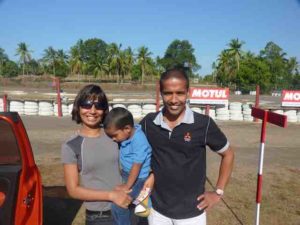
It always pays to know people.
It certainly pays to have contacts. They say it’s not what you know it’s who you know. I say it’s both. Today I had some great contacts. As an outcome of my participation in the autolanka.com online forum, I was contacted by Mr. Dinesh Deheragoda. Dinesh is the Managing Director of the Ceylon Black Tea Company in Sri Lanka during the day. He is also a racing driver over the weekend. It was fun meeting both Dinesh and his family.
Dinesh wanted to make sure I had a good time at the track today. He made arrangements for me to get into the races on a complimentary basis. I had spoken to Dinesh several times leading up to the event including today. It pays to have important people on your side in life as well as in trackchasing.
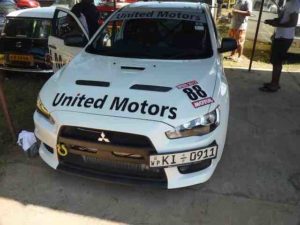
This wasn’t your average street stock racer.
Dinesh had his racecar parked near the entrance of the paddock area. Today would be the first race for his brand new 2012 Mitsubishi Evolution. Just like the NASCAR boys used to do back in the 50s, Dinesh had a brand new car delivered, then gutted it and refitted the vehicle with a roll cage and other items to make it race ready. Who does that these days? Very few indeed. I was surprised to see the white backup lights go on when the car moved in reverse. That’s how “stock” much of the car was.
I asked him what a car like this would cost. He told me that a car like his sells for $42,000 U.S. in Japan. Then you had to add shipping, tariffs and taxes to the total to get it to Sri Lanka. From that point, there would be the expense of turning the car into a safe racer. This was one expensive venture. However, like me, Dinesh has sponsors that help foot the bill. The racing purse certainly doesn’t add much. Dinesh told me they race for $200 U.S. to win….at the most. Some races, even though they might be televised live don’t have any purse.
Next up was a meeting with the president.
The president of the race group that is. Following my meeting with Dinesh I was off to introduce myself to Niroshan Pereira. Niroshan is the president of the Ceylon Motor Sports Club (The club). He wanted to make sure I was comfortable. He asked me if I was “with anyone”.
I looked over and pointed to Ariya, my personal driver. Ariya had begun the trip as my driver. However, for today’s race he was being promoted to my assistant! Niroshan arranged for Ariya and me to get media passes. This allowed us to go anywhere around the Pannala Circuit that we wanted.
When those formalities were taken care of, Ariya and I were invited to take a lap around the track in the pace truck. I’ve done that many times before. However, I’m sure this was a first for Aryi. He couldn’t stop smiling.
The track had scheduled an ambitious race itinerary.
Today’s racing program had 18 races scheduled every fifteen minutes beginning at 9:15 a.m. The track itself is a 1.7-mile asphalt road course with multiple elevation changes. Fans are allowed to walk nearly everywhere to get a good view. By walking around the outside of the circuit, the cars can be seen 100% of the time. However, at anyone point only about 50-60% of the track can be seen.
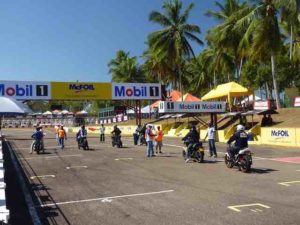
Motorcycles too.
In addition to several classes of cars there were motorcycle races today as well. Six of the races were for two-wheelers. The motorcycle racers pitted on the other side of the race course from the car’s paddock area. I ventured over there during the course of the racing action.
Fantastic hospitality.
I had a good time talking with several of the riders and their pit crews. They even bought me a concession treat of fresh pineapple. Here’s a first. What do you thing they sprinkled on the pineapple? Salt and Pepper!
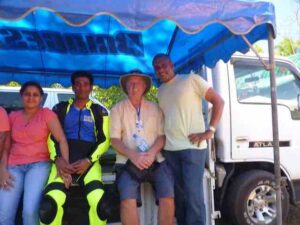
I had a great discussion about Sri Lankan culture with this group. They found it funny when I told them about the crazy traffic situation they have. They told me that “once you live here you just get used to it”. We also talked about the Civil War that went on for thirty years and only ended in 2009. One fellow said the bombing was so bad you never knew if you would make it home at the end of the day.
The weather was both hot and humid and not much to my liking. I wondered if they started racing so early in the day while trying to avoid the heat of the day. Nope! They just like to start early in the day I was told.
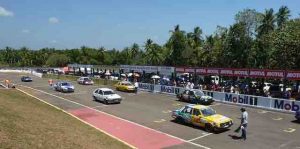
Short races with small fields.
The races ranged in distance from six to ten laps. Each class had only one race. Most races had 6-10 competitors. The car classes included Formula McClarens and several sports car classes with engine sizes up to 1,600 cc.
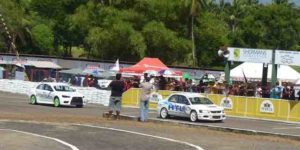
The most exciting race of the day.
The next to last race of the day featured my friend Dinesh racing. This was the “big dog” class where the fastest speeds were turned. Dinesh started in fourth place (the cars had timed in on Saturday) in the ten-car field. It was fun be able to cheer for someone I knew in this race.
He drove a solid race and gained a spot here and there until he was riding in second place with one lap to go. The cars left my sight and when they emerged Dinesh was leading. He went on to win the race in his car’s first ever racing appearance.
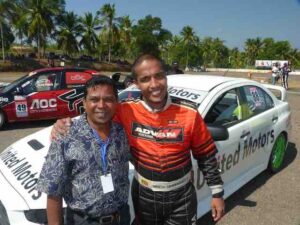
After the races, Dinesh who bears a strong resemblance to Barrack Obama, was mobbed with well wishers. When the celebration subsided Ariya and I went over to congratulate Dinesh. He spent several minutes talking with us and posing for pictures in front of his winning car. I enjoyed the moment and I know my new “assistant” Ariya did too.
Surprisingly, there’s a lot of wheel to wheel racing in Sri Lanka.
Overall, it was a fun day at the races. In my conversation with Dinesh I was surprised to learned that Sri Lanka has 7-8 racetracks that offer wheel to wheel racing. They even have a street race each December in Colombo. Dinesh told us several of the tracks offer only a gravel racing surface.
Sri Lanka is a long way from home for me. Their lifestyle and culture is a “long way” from what I’m used too. I feel very fortunate to have traveled more than 22,000 miles to meet up with new friends I first met on the internet. It was great meeting so many new folks once I got to the track. A few have already contacted me via email, my guestbook or text message and I’m not even home yet. It was also a great treat for me to see Ariya enjoying himself so much and being exposed to my trackchasing hobby.
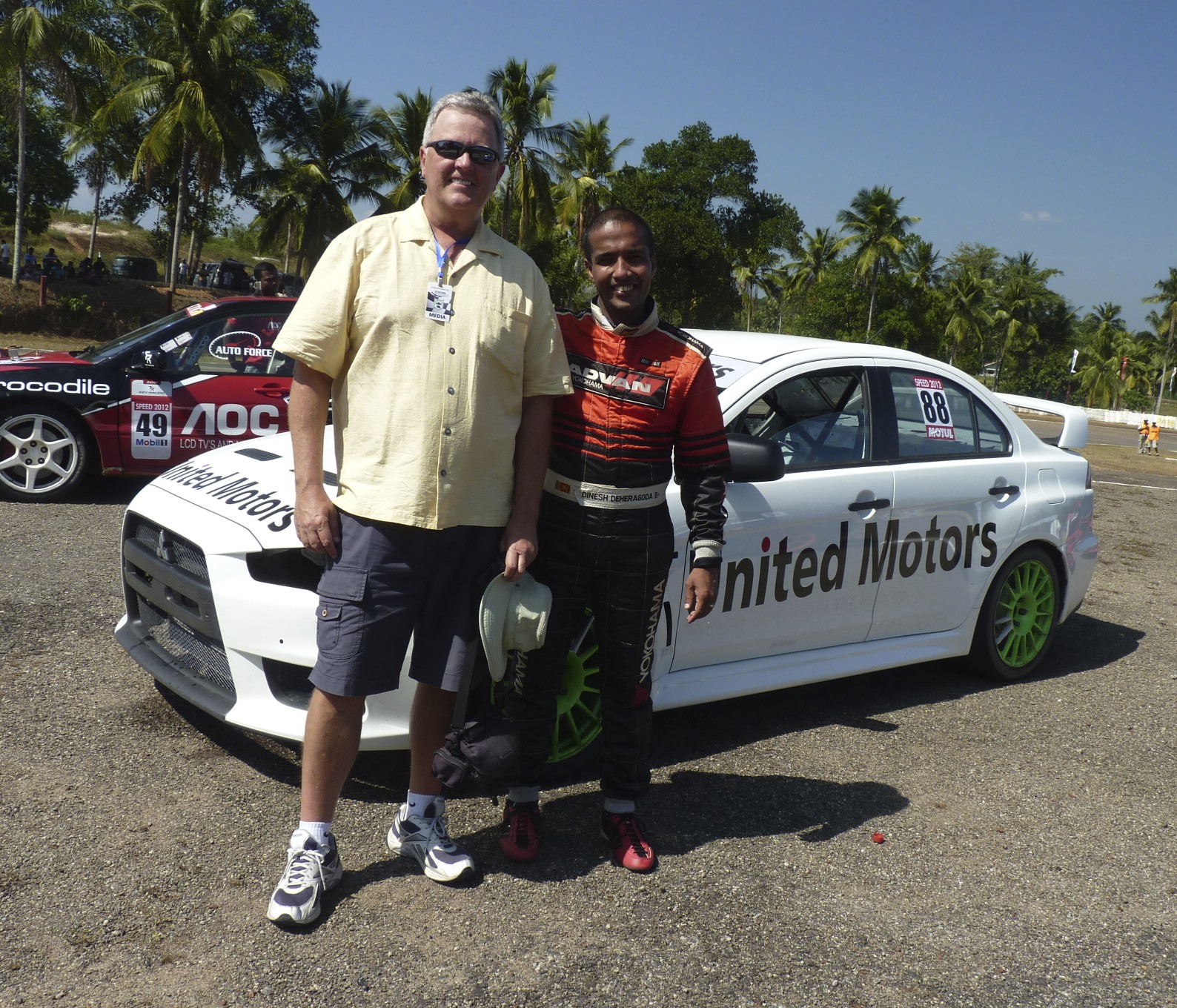
I get to celebrate with Dinesh in victory lane!
There were lots of people to thank today.
Major thanks are deserved by Dinesh, Niroshan and everyone else I met at the track today. Please don’t miss the pictures. They will bring this story to life. Getting trackchasing country #57 in a place like Sri Lanka was priceless.
It had been a long hot day. I had walked over nearly every square centimeter of the Pannala Race Track. Everyone I met at the track was friendly. Everyone I met in Sri Lanka was friendly. Other than the heat and humidity of the afternoons, the trip met and exceeded my expectations.
My Sri Lankan security vault and information center power source.
The drive from the track to my hotel in Negombo took about an hour. I’ve been using Aryi’s Nissan wagon for more than just transportation. It’s been a security vault and power source for my information center as well. What do I mean by that?
Each time we left the car I always used my security cable to make sure my laptop was still there when we returned. I simply ran the cable through the steering wheel!
My systems have not always worked.
Recall a few years ago, I did this at an ice race in Quebec. However, at the time I was using a key lock and not a combination lock. I promptly lost the key somewhere in the ice and snow. That created one of the funniest and most angst filled trackchasing moments of my career when I returned to the car. I drove the car all the way back to Montreal without being able to turn the steering wheel fully because of the security cable running through the steering wheel! However, I am all about “systemic improvement”. I can’t lose a key now. I use a combination lock.
In addition to this security feature my private car hire’s power adapter kept my computer and camera fully charged. That was needed when I found the electrical outlets too old in my guesthouse to work with my international electrical adapter. I simply used my “Radio Shack inverter” to transfer the power from the car’s electrical system to my laptop and re-chargeable camera batteries. It’s all about systems baby.

I can’t do this on an international basis without sponsorship.
On my final night in Sri Lanka I would receive a sponsorship at the upscale (compared to where I’ve been staying) Ramada on Negombo near the Colombo International Airport (Ramada). Check out these numbers. I will be away from home for six nights. Three of those nights will be spent on airplanes. Two of them were at an older private guest house at a rate of $27 U.S. per night. The final night in Sri Lanka was my first night in a real hotel. However, the Wyndham Rewards program was sponsoring my stay at no expense to me.
Let’s do the math. I was gone for six nights. My total lodging expense was $54 U.S. or an average of nine dollars per night. You all know by now I don’t have the budgets of those mega race teams from the east, often referred to as the “Dreaded East Coast Trackchasers”. I guess this proves the little guy (the big guy in my case) really can compete if they have a plan.
These boys weren’t quite with it.
Of course, no system is perfect. The “boys at the Ramada” acted as if they had never heard of the “Wyndham Rewards” program or the “World’s #1 Trackchaser” for that matter. That’s when more of my systems had to be used.
I popped open my iPhone (O.K., you don’t really ‘pop open’ an iPhone) to show them the details of my Ramada reservation. It called for a “one-bedroom king suite”. Since they were such semi-jerks about it I made them prepare the second room as my “parlor” even though I wouldn’t use it all. These guys were about the only people who weren’t all that cooperative during my stay in Sri Lanka. However, I used just a little bit of “New York mentality” and they had no choice but to cooperate.
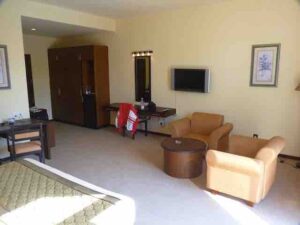
The bellboy told me I had the “best room in the hotel”. That was good as I had not stayed in a quality place since I left home from San Clemente. A shower in my (for Sri Lanka) palatial estate felt good. I was too tired to go out or even venture down to the hotel restaurant. Instead I ordered room service.
Sri Lanka has the lowest restaurant prices of any country I can remember.
Normally, room service prices can be up to 50% more expensive than eating in the hotel restaurant. That’s one of the reasons I am never a big fan of room service or hotel restaurants for that matter. I think hotel restaurants are for the “less adventuresome” tourist.
Tonight, the room service prices bordered on the unbelievable. They were unbelievably low! The pepper steak entrée complete with sides was $6.56 U.S. An order of chicken wings was $2.62 U.S. I would have thought the prices would have been 3-4 times that or more. Eating in restaurants in Sri Lanka has been dirt cheap.

I settled on an order of French onion soup ($2.40 U.S.), an Asian dish of fried noodles (similar to angel hair pasta) and chicken ($3.94 U.S.) and the chicken wings. The chicken wings truly were “wings” no drumsticks which are my favorite. Then I went to bed at 8 p.m. which is 6:30 a.m. San Clemente time. It will be fun “re-adjusting” when I get back home. However, I will only be home for 24 hours or so. Then Carol and I head to New York for nearly a week.
I’m not done yet!
However, I am not done touring on this trip just yet. There are a couple more things to see and do. Good night!
Monday – Day 6 – Negombo, Sri Lanka and beyond!
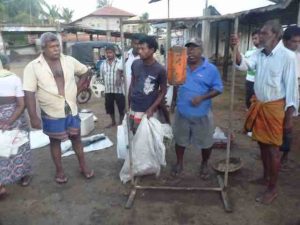
One more Sri Lankan tourist stop.
My flight leaves Colombo, Sri Lanka at 9:50 a.m. today. However, there’s still time for one more tourist stop. My TripAdvisor friends told me the “Negombo Fish Market” is an interesting sight to see. They said it’s best to go in the morning at the peak of activity. To make this happen Ariya would pick me up at 6 a.m. We’d stop at the fish market for a few minutes, get some pictures and soak up the “ambience” and then be off to the airport. No, I can never get enough of new experiences.
Ariya was waiting for me in the lobby right on time. It was still dark out. For the last time, I jumped in his Nissan wagon and we went to explore Sri Lanka. Specifically, that would be the Negombo Fish Market just twenty minutes up the road.
When we arrived the sun had risen. However, both Ariya and I agreed there wasn’t much activity. It wasn’t long before some locals told us there was a “strike” going on. Nevertheless, there was some fish commerce taking place. Maybe one hundred people were buying and selling small lots of several different types of seafood.
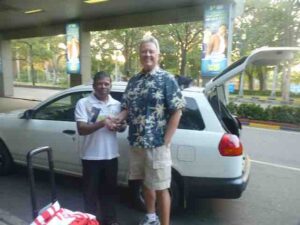
It was time to say good-bye to my driver, Ariya.
From there it was on to the airport. During the ride Ariya gave me a very neatly printed piece of paper with his name and address on it. He told me several times during the past day or so, “Any time you come back to Sri Lanka with your family you can stay at my house or my sister’s house”. Normally, I would just take this as hype from the tourism industry. However, after spending an afternoon with Ariya at his sister’s house for no commercial gain on his part I believed him.
The TripAdvisor Sri Lankan forum had advised tipping drivers 500 rupees per day (about $5 U.S.) if you were satisfied with the service. Ariya did not speak English well as had been intimated by the supervisor at the Tourist Drivers Association. However, when I wanted something or needed anything Ariya understood and did his level best to make certain my every need was met. He did a fantastic job in this area of his responsibilities. He was also an EXCELLENT driver and that skill is absolutely required in Sri Lanka.
Despite speaking different languages we had formed a bond.
When we pulled up to the curb at the airport, Ariya went to the back of the car to get my bag. He had a huge smile on his face and stuck out his hand to shake mine. I truly believe that if I had not tipped him anything he would have been just as happy. I know he loved taking me to his sister’s house. He was also very proud of wearing his “media credentials” lanyard at the racetrack. I suspect he had never received such V.I.P. attention.
I handed him a large amount of rupees as his tip. He didn’t even look at it. He simply put it in his pocket and kept on smiling and wishing me well. I wanted to see what his reaction was to the tip. The reason being is that I then doubled that amount. Same reaction, lots of smiling and “I hope you come back” vibes. Finally, I pulled out a piece of paper where Ariya had provided the names of his sister, brother-in-law and their daughters. I handed him a large bill Sri Lankan bill and said, “Give this to Ashini and Chahani and tell them to have a good time”. I think he understood what I meant.

If I was wealthy, like those “Dreaded East Coast Trackchasers”, I would go around like they used to do on the old TV show, “The Millionaire” and find deserving people and reward them handsomely. Ariya and his family are very deserving people.
I still had some travelin’ to do.
I was nearly three hours early for my Emirates Airlines flight from Colombo, Sri Lanka to Dubai, United Arab Emirates. Once in Dubai I would have nearly a 12-hour layover. This would give me time to ride the metro toward the city and explore Dubai a bit.
But first it was “postcards and gift buying time”. Carol sends out 15-20 postcards mainly to the various kids in our family for each trip she makes. She normally stops the practice when they graduate from college. However, some have asked her to continue sending the cards even after they have graduated!
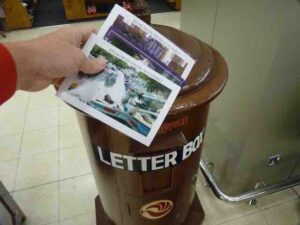
I never forget those back home.
I bought cards and stamps for our immediate family. Then I jotted some notes and dropped the cards off in a very cute little postal box in the terminal. My gift shopping consisted of various jars of cashews grown in Sri Lanka. Those gifts go along with a very colorful and educational “elephant puzzle” for those darling nearly four years of age now grandbabies.
Home was just 11,000 miles ‘up the road’.
From there it was off to Dubai and the first of three plane rides that would get me back to Los Angeles. All three of the flights I needed to get back home would be flying in an westerly direction. That meant the flying time would be longer because we were flying against the prevailing winds.
A chance to visit Dubai.
My layover in Dubai would be twelve hours. I could simply stay at the airport, it’s one of the best in the world for shopping, etc. Or, I could venture into Dubai for several hours. You can probably guess what I did.
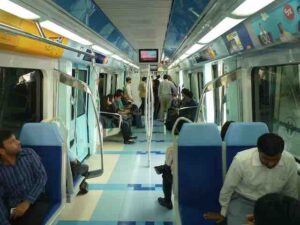
I wanted to ride Dubai’s new “metro” subway system. It’s been open for about two years now. When Carol and I were last, it was within a few months of opening.
But first I had to clear the United Arab Emirates customs. That was easy and put another stamp in my passport. No visa needed to enter the UAE. I should note I’m not looking to put more stamps in my passport. I’ve already added 48 extra pages to it. My passport is about as thick as a small bible. A new fee of about $80 is required to add each 24 more pages. It used to be free to do that. I’ll be getting a brand new passport in 2014.
I had to clear UAE customs simply to get my checked bag from the Sri Lanka flight. Emirates Airlines had required that I check it, for free, because of its large size.
Aptly named, ‘Left Luggage’.
Now that I had my carryon bag again, I didn’t want to drag it all around Dubai. I would use the “left luggage” service at the airport. For a fee of $20 UAE dirham, I could leave it at the left luggage area for up to twelve hours. They only accept cash at left luggage. That meant I had to exchange some U.S. funds for UAE dirhams.
I plunked down a $20 U.S. bill and received 72 dirhams (3.6 UAE dirhams to the dollar). I figured what I didn’t spend I could just turn back into U.S. dollars. That was until the money changer told me there would be a $4 U.S. fee for the return privilege. I would just spend my $20 worth of UAE money.
It takes a good deal of trust to leave all of your personal information (via my laptop) with a stranger. If I returned and my laptop was gone that would be very bad, very bad indeed.

Dubai Metro here I come.
With my carryon bag safely stowed in left luggage (I sure hoped) I walked over to the Dubai metro stop for terminal 3 at the airport. I could have charged my round-trip ticket but instead paid cash (15 dirham) for the ride.
An Emirates flight attendant had recommended a stop at the Dubai Marina. I didn’t think I had been there. The metro looks new and is very quiet to ride. It wasn’t all that crowded in the mid-afternoon. I grabbed an end car that provided a spectacular view of the Dubai skyline. It goes on for miles.
I passed several stops that were familiar to me. That’s one of the drawbacks, in my opinion, to the Dubai Metro. It stops too many times. It took me nearly 45 minutes to reach the marina. I got on at stop #13 at the airport (terminal 3) and the marina was stop #36. There were 4-5 numbers in between that don’t have a stop yet. Nevertheless, for a 20-mile or so ride (I’m guessing) that’s a lot of stops.
The marina area didn’t look that promising. I didn’t feel like walking for miles so I hopped another train heading in the other direction back to stop #32. This stop is called “Mall of the Emirates”. You may have seen the mall’s claim to fame. They have an INDOOR snow skiing slope some 400 meters in height. The entire skiing structure looks like a huge sunglasses case tipped on one end from the outside.
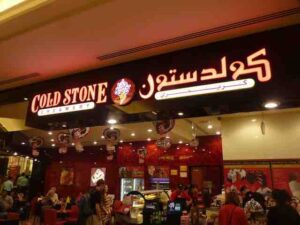
I had to spend my dirhams wisely…but I had to spend them.
I had 57 dirhams burning a hole in my pocket. Remember, I had to hold back twenty dirham to get my bag out of left luggage. First, I stopped and bought a scoop of “cake batter” ice cream at the Cold Stone Creamery and a bottle of water. That took 23 dirham leaving me with just 14 available dirham or about four dollars.
It was surprising to see how many American brands there are in the mall. You might even think you were walking in your own shopping mall back home and not some place in the middle of the Arabian desert. I even saw a huge billboard for a Tim Horton’s restaurant. Can you imagine!
Just enough time to see a film.
I had a good 5-6 hours to spend just nosing around. When I travel internationally I enjoy going to the movies. I like to do that with Carol back home too. I was in luck. The moving “Iron Lady” was playing with Meryl Streep. I’m a Meryl Streep fan. She is obviously an Oscar worthy actress in this film. I didn’t have enough U.A.E. cash so I charged my movie ticket.
This is a common problem.
This is when I learned my Visa credit card was no longer working. I had forgotten to tell the Visa boys and girls that I would be heading to Sri Lanka. MasterCard came to my rescue. I really liked the movie although the constant changing back and forth between time periods confused me a bit. I was reminded they sell reserved seats to the movies in this part of the world.
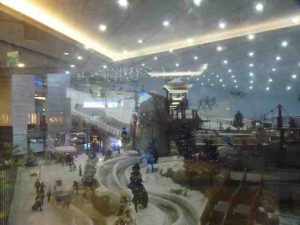
After the film I took some photos of people skiing indoors on manmade snow. That’s a pretty cool trick especially when the temperature in the summer time can easily reach 115-120 degrees Fahrenheit outside.
What’s to eat?
Then I was off in search of dinner. Shopping malls are huge tourist attractions all over the world, often because they provide air-conditioning. In Dubai about 20% of the people can be seen wearing birkas (garb of the Muslim faith) in public. The whole “get-up” looks very comfortable!
These malls are famous for their food courts. If you’ve never seen an Asian megamall food court you’re in for a treat. I carefully reviewed more than thirty choices. Finally, I decided on an Indian restaurant. I went through the menu and when I placed my order I told them my Visa card wasn’t working and I would be using my MasterCard. No, I wouldn’t. They didn’t accept credit cards. Most of the restaurants in the food court didn’t either. I needed a back up plan.
What could I have to eat for 14 dirham?
I didn’t want to exchange any more money into UAE dirhams. Carol probably has a stash of this currency in her “bank” back home. I had 14 dirhams left. What could I buy with that?
I looked up and saw a KFC outlet. As I approached I noticed a three-piece chicken strip meal (my favorite KFC menu item) without drink for 11 dirham. Maybe that would work. I walked up to the counter and asked what this choice WITH a small drink would cost. The answer: 16 dirham. I told the young clerk, who looked like the manager, “I only have 14 dirham in your currency”. He looked at me and shrugged. “Don’t worry I will take that” he told me, “No problem”. Now I was moving into the world of the homeless. It did make me feel strange.
I had to get moving….at about 550 M.P.H.
When the rest of my shopping mall tour was over I walked a few hundred yards, all indoors, back to the metro. It was about 8 p.m. on a Monday evening. Now the metro was packed. A train comes by each stop every eight minutes. I arrived back at the airport with a 20 dirham bill in my pocket. When I retrieved my bag from “left luggage” I was back to zero dirhams. My short Dubai visit had been perfect for this layover at the airport.
I was hoping to get business class back to Washington, D.C. from Dubai. Heading westward it would be a 14-hour flight. However, the best I could do was “economy plus”. I did get a bulkhead seat on the “two-side” with no one next to me. That would be just fine from my sponsored airline.
The flight from Colombo, Sri Lanka had been nearly five hours long with a one-hour delay while we were on the plane. I would clear U.S. customs in Washington, D.C. (always a slow process there) after a 14-hour flight. I wouldn’t be home yet. It’s a five hour plus flight from D.C. to LAX. Then I would have more than an hour’s drive in city traffic in Los Angeles to get home. Maybe there’s a reason that no one does it this way with any frequency.
Tuesday – Day 7 – Dubai to Washington, D.C. to Los Angeles to San Clemente.
7-6-57.
“7-6-57”. No, that’s not my birthdate (I wish it was) or the lottery numbers I play (I don’t play the lottery). It’s a seven-day/six-night trip acronym for what yielded trackchasing country #57. I was at the racetrack for about eight hours. The rest of the time I was just soaking up experiences.
I’ve got enough toys for a boy my age.
Frankly, I have about all of the material things I need. I don’t play the lottery. I invest my money for a rainy day. I do know two things, maybe three about lotteries. First, you can’t win unless you own your own bowling shoes (remember much of the humor you read in these pages in on the subtle side), secondly you’re chances of winning are roughly the same whether you buy a ticket or not. Finally, most people who win the lottery are too old to enjoy it.
I told a friend the other day that I wouldn’t know what to do if I DID win the lottery. I can’t think of virtually a thing I would need to buy. He told me he misses his private jet which he had to sell during the economic downturn! Everybody’s got their problems, right.
One can never have enough experiences.
The one thing I guess I don’t have enough of is experiences. I can’t imagine ever maxing out in this area. My mission is simply to keep accumulating new experiences until I can’t do it anymore. Sri Lanka fit the bill there.
It’s the ‘chase not the race’.
My hobby is about the “chase not the race”. Jane Miller of the Peoria Journal Star coined that phrase when she wrote about my trackchasing. For this trip I was gone for about 144 hours and eight of those were spent at a racetrack. I loved those eight hours. But I liked what I got to see and do during the other 136 hours just as much and probably more. Will there be more trackchasing countries for me? I sure hope so.
Without too much further adieu and many hours later, I arrived back into the loving arms of “Trackchasing’s First Mother” as we began the first day of our 41st year of marital bliss.
RLR – Randy Lewis Racing Lifetime Trackchasing Countries
# 1 – UNITED STATES OF AMERICA – Peoria Speedway – Mt. Hawley, (oval) – Track #1, Peoria, Illinois – circa 1954 (age 5)
# 2 – CANADA – Cayuga Speedway (oval) – Track #174, Nelles Corner, Ontario, Canada – July 31, 1988 (Dick Trickle winner)
# 3 – AUSTRALIA – Parramatta City Raceway (oval) – Track #180, Granville, New South Wales, Australia – November 17, 1989 (accompanied by Carol)
# 4 – UNITED KINGDOM – Northhampton International Raceway (oval) – Track #378, Northhampton – June 26, 1999 (accompanied by Carol, Kristy, Jim)
# 5 – NETHERLANDS – Driesum Racetrack (oval) – Track #839, Driesum – May 5, 2005 (accompanied by Roland Vanden Eynde)
# 6 – BELGIUM – Bellekouter oval (oval) – Track #841, Affligem – May 8, 2005 (accompanied by Roland Vanden Eynde)
# 7 – FRANCE – Circuit de Croix en Ternois (road course) – Track #843, Saint-Pol sur-Ternoise – May 8, 2005 (accompanied by Roland Vanden Eynde – 2nd new country in one day!)
# 8 – GERMANY – Nurburgring (road course) – Track #844, Nurburg – May 13, 2005 (accompanied by Carol, Roland Vanden Eynde)
# 9 – NEW ZEALAND – Western Springs Speedway (oval) – Track #1,134, Western Springs – December 26, 2006 (accompanied by Carol)
# 10 – MEXICO – Triovalo Bernardo Obregon (oval) – Track #1,281, Tiajamulco de Zuniga, Jalisco – October 14, 2007 (accompanied by Carol, J.J., Roger Ward)
# 11 – BARBADOS – Bushy Park Racing Circuit (road course) – Track #1,296, Bushy Park – December 9, 2007
# 12 – THAILAND – Bira Circuit (road course) – Track #1,300, Pattaya – January 19, 2008
# 13 – SOUTH AFRICA – Durban Grand Prix (road course) – Track #1,315, Durban, KwaZulu-Natal – February 24, 2008 (accompanied by J.J. and Will Van Horne)
# 14 – JAMAICA – Dover Raceway (road course) – Track #1,322, Brown’s Town St. Ann – March 24, 2008
# 15 – SWEDEN – Sturup Raceway (road course) – Track #1,335, Malmo – May 10, 2008 (accompanied by Carol)
# 16 – DENMARK – Ring Djursland (road course) – Track #1,336, Tirstrup – May 11, 2008 (accompanied by Carol)
# 17 – CZECH REPUBLIC – Automotodrome BRNO (road course) – Track #1,381, Brno – September 13, 2008
# 18 – AUSTRIA – Lambrechten Stock Car Track (road course) – Track #1,382, Lambrechten – September 14, 2008
# 19 – IRELAND – Tipperary International Raceway (oval) – Track #1,388, Rosegreen – October 26, 2008 (Carol and I visited this track earlier in the year)
# 20 – GUYANA – South Dakota Circuit (road course) – Track #1,390, Timehri – November 2, 2008 (accompanied by Carol)
# 21 – CHINA – The Guia Circuit (road course) – Track #1,392, Macau – November 16, 2008 (accompanied by Carol)
# 22 – COSTA RICA – Autodromo La Guacima (road course) – Track #1,398, La Guacima – November 30, 2008
# 23 – ANDORRA – Grandvalira Circuit (road course) – Track #1,404, Port d’Envalira, Andorra – January 17, 2009
# 24 – ARGENTINA – Circuito Efren Chemolli (oval) – Track #1,406, Buenos Aires, Argentina – January 31, 2009 (shared with Jerry Fisher)
# 25 – QATAR – Losail International Circuit (road course) – Track #1,408, Doha, Qatar – February 13, 2009
# 26 – BAHRAIN – Bahrain International Circuit (road course) – Track #1,410, Sakhir, Bahrain – February 27, 2009 (accompanied by Carol)
# 27 – UNITED ARAB EMIRATES – Dubai Autodrome (road course) – Track #1,411, Dubai, United Arab Emirates – February 28, 2009 (accompanied by Carol)
# 28 – COLOMBIA – Autodromo de Tocancipa (road course) – Track #1,415, Tocancipa, Colombia – March 22, 2009
# 29 – SPAIN – Motorland Aragon (road course) – Track #1,416, Alcaniz, Spain – March 28, 2009
# 30 – PORTUGAL – Circuto de Murca (road course) – Track #1,417, Murca, Portugal – March 29, 2009
# 31 – ICELAND – Kapelluhraum (road course) – Track #1,420, Hafnafjorour, Iceland – April 25, 2009 (shared with Will White)
# 32 – HUNGARY – Hungaroring (road course) – Track #1,426, Mogyorod, Hungary – May 8, 2009 (accompanied by Carol)
# 33 – SWITZERLAND – Hock Ybrig (road course) – Track #1,427, Hoch Ybrig, Switzerland – May 9, 2009 (accompanied by Carol)
# 34 – ITALY – Vighizzolo d’Este Stock Car Track (road course) – Track #1,428, Vighizzolo d’Este, Italy – May 10, 2009 (accompanied by Carol)
# 35 – DOMINICAN REPUBLIC – Autodromo Mobil 1 (road course) – Track #1,515, Santo Domingo, Dominican Republic – December 6, 2009 (accompanied by Carol)
# 36 – MALTA – Ta’Qali Race Track (road course) – Track #1,521, Ta’Qali, Malta – February 7, 2010 (accompanied by Carol)
# 37 – FINLAND – Lake Pidisjarvi Ice Track (road course) – Track #1,524, Nivala, Finland – February 20, 2010
# 38 – JAPAN – Suzuka Circuit (road course) – Track #1,530, Suzuka, Japan – March 21, 2010
# 39 – CHILE – Autodromo de Interlomas (road course) – Track #1,531, Temuco, Chile – April 18, 2010
# 40 – MOROCCO – Circuit de Marrakesh (road course) – Track #1,535, Marrakesh, Morocco – May 1, 2010 (accompanied by Carol)
# 41 – BRAZIL – Circuit de Caruaru – Aryten Senna (road course) – Track #1,540, Caruaru, Brazil – May 16, 2010 (accompanied by Carol, Jerry Fisher and Katina Spencer)
# 42 – ESTONIA – Laitse Rally Park (road course) – Track #1,571, Laitse, Estonia – July 24, 2010 (accompanied by Carol)
# 43 – LATVIA – Bikernieki (road course) – Track #1,572, Riga, Latvia – July 25, 2010 (accompanied by Carol
# 44 – GUATEMALA – Autodromo Pedro Cofino (road course) – Track #1,580, Alotenango, Guatemala – August 15, 2010
# 45 – EL SALVADOR – El Jabali (road course) – Track #1,582, Quezaltepeque, El Salvador – August 22, 2010 (accompanied by Carol)
# 46 – ROMANIA – Bradu (road course) – Track #1,603, Bradu, Romania, El Salvador – October 16, 2010
# 47 – BULGARIA – Closed Route – Burgas (road course) – Track #1,604, Burgas, Bulgaria – October 17, 2010 (accompanied by Lyubomir and Plamen Simeonov)
# 48 – SOUTH KOREA – Korea International Circuit (road course) – Track #1,605, Yeongam, Jeollanam-Do, South Korea – October 24, 2010
# 49 – PHILIPPINES – Batangas Racing Circuit (road course) – Track #1,608, Batangas, Philippines – November 21, 2010
# 50 – NORWAY – Lyngas Motorbane (road course) – Track #1,648, Lier, Norway – April 30, 2011
# 51 – MALAYSIA – Sepang International Circuit (road course) – Track #1,656, Sepang, Malaysia – May 28, 2011
# 52 – INDONESIA – Sentul International Circuit (road course) – Track #1,657, Babakan Madang, Boder, Indonesia – May 29, 2011
#53 – LUXEMBOURG – Alzingen (road course) – Track #1,711, Alzingen, Luxembourg – September 4, 2011 (accompanied by Carol)
# 54 – POLAND – Tor Slomczyn (road course) – Track #1,713, Slomczyn, Poland – September 11, 2011 (accompanied by Carol)
# 55 – SINGAPORE – Marina Bay (road course) – Track #1,714, Singapore, Singapore – September 24, 2011 (accompanied by Carol)
# 56 – URUGUAY – Piriapolis Grand Prix (road course) – Track #1,724, Piriapolis, Uruguay – November 12, 2011
# 57 – SRI LANKA – Pannala Race Track (road course) – Track #1,732, Pannala, Sri Lanka – February 12, 2012
The ‘International Big 5’ standings.
During the last 52 months, I have added 48 trackchasing countries to my list. That’s an average of nearly one new country every month for going on five years.
1. Randy Lewis, San Clemente, California USA – 57
2. Roland Vanden Eynde, Vilvoorde, Belgium – 50
3. Carol Lewis, San Clemente, California USA – 28
4. Will White, Quakertown, Pennsylvania USA – 25
5. Chris Economaki, Charlotte, North Carolina USA – 20
I hope to have a good year of international trackchasing.
I started the year having seen racing in 56 different countries. Sri Lanka becomes country #1 for 2012. I figure I might as well see as many new countries as I can while I have the resources and good health.
2012 Country List
Sri Lanka
This was a most unusual country to begin with for the year. Am I finished adding new countries to this year’s total? No. I’m just getting started! I’ve got a lot of “international irons in the fire”. My “fishing” net is being cast wide and far. We’ll just have to see how much cooperation I get from the United States State Department and various foreign governments. As international trackchaser Will White says, “I would never be surprised to see you show up anywhere in the world”. Of course, his words are loosely translated.
Thanks for reading about my trackchasing,
Randy Lewis
World’s #1 Trackchaser
Life should NOT be a journey to your grave with the intention of arriving with a well-chiseled and honed body but rather to crash in, riding your golf cart up the 18th fairway with a glass of single malt in one hand and a brownie in the other. You should be totally worn out and used up with a tattoo on your chest proclaiming, “What a ride”.

Sri Lanka – FAST FACTS*
Sri Lanka officially the Democratic Socialist Republic of Sri Lanka is a country off the southern coast of the Indian subcontinent in South Asia. Known until 1972 as Ceylon, Sri Lanka is an island surrounded by the Indian Ocean, the Gulf of Mannar, the Palk Strait, and lies in the vicinity of India and the Maldives.
Sri Lanka has also been a center of the Buddhist religion and culture from ancient times, and is one of the few remaining abodes of Buddhism in South Asia along with Ladakh, Bhutan and the Chittagong hill tracts. Sri Lanka is a republic and a unitary state which is governed by a semi-presidential system. The country is famous for the production and export of tea, coffee, coconuts, rubber and cinnamon, the last of which is native to the country. The natural beauty of Sri Lanka has led to the title The Pearl of the Indian Ocean.
ETYMOLOGY
In ancient times, Sri Lanka was known by a variety of names: Known in India as Lanka or Singhala, ancient Greek geographers called it Taprobane and Arabs referred to it as Serendib (the origin of the word “serendipity”). Ceilão was the name given to Sri Lanka by the Portuguese when they arrived in 1505, which was transliterated into English as Ceylon. As a British crown colony, the island was known as Ceylon, and achieved independence under the name Dominion of Ceylon in 1948. In 1972, the official name of the country was changed to “Free, Sovereign and Independent Republic of Sri Lanka”. In 1978 it was changed to the “Democratic Socialist Republic of Sri Lanka”. The name Ceylon is still in use in the names of a number of organisations; in 2011, the Sri Lankan government announced a plan to rename all of those for which it is responsible.
MODERN SRI LANKA
Sri Lanka under the British rule
By this time, experiments with coffee plantation were largely successful. Soon it grew to become the primary commodity export of the country. The falling coffee prices as a result of the depression of 1847 stalled economic development and prompted the governor to introduce a series of taxes on firearms, dogs, shops, boats, etc., and reintroduce a form of rajakariya, requiring six days free labour on roads or payment of a cash equivalent. These harsh measures antagonized the locals, and another rebellion broke out in 1848. A devastating leaf disease, Hemileia vastatrix, struck the coffee plantations in 1869, destroying the entire industry within 15 years. The British officials desperately searched for a substitute, and the promising replacement they found was tea. Production of tea in Sri Lanka thrived within the decades to come.
By the end of the 19th century, a new educated social class which transcended the divisions of race and caste was emerging as a result of British attempts to nurture a range of professionals for the Ceylon Civil Service and for the legal, educational, and medical professions. In the meantime, attempts were underway for Buddhist and Hindu revivalism and to react against Christian missionary activities on the island.
Post independence Sri Lanka
The Soulbury constitution ushered the Dominion status for Ceylon, delivering it independence on 4 February 1948. Although the country gained independence in 1948, the British Royal Navy stationed at Trincomalee remained until 1956. With the election of S. W. R. D. Bandaranaike to the prime ministership in 1956, Ceylon began moving towards better relations with the communist bloc. Bandaranaike’s 3 year rule had a profound impact on the direction of the country. He emerged as the “defender of the besieged Sinhalese culture” and promised radical changes in the system. He introduced the controversial Sinhala Only Act, recognising Sinhala as the sole official language of the government. Although it was partially reversed in 1958, the bill posed a grave concern for the Tamil community, which perceived their language and culture were threatened. The Federal Party (FP) launched satyagraha against the move, which prompted Bandaranaike to reach an agreement (Bandaranaike-Chelvanayakam Pact) with S. J. V. Chelvanayakam, leader of the FP, to resolve the looming ethnic conflict. Bandaranaike was assassinated by an extremist Buddhist monk in 1959.
Sirimavo Bandaranaike, the widow of late S. W. R. D. Bandaranaike, took office as prime minister in 1960, but faced an attempted coup d’état in 1962. During the second term as prime minister, her government instituted socialist economic polices, further strengthening ties with the Soviet Union and later China, while promoting a policy of non-alignment. However in 1971, Ceylon experienced a Marxist insurrection, which was quickly suppressed. In 1972, with the adoption of a new constitution, the country became a republic, repudiating the Dominion status and changing its name to Sri Lanka.
The Government of J. R. Jayawardene swept to power in 1977, defeating the largely unpopular United Front government, towards its final years. Jayawardene introduced a new constitution, together with a powerful executive presidency modelled after France, and a free market economy. It made Sri Lanka the first South Asian country to liberalise its economy. However from 1983, ethnic tensions blew into on-and-off insurgency.
Sri Lanka was affected by the devastating 2004 Asian tsunami, which left at least 35,000 people dead. From 1985 to 2006, Sri Lankan government and Tamil insurgents held 4 rounds of peace-talks, none of them helping a peaceful resolution of the conflict. In 2009, under the Presidency of Mahinda Rajapaksa the Sri Lanka Armed Forces defeated the LTTE, and re-established control of the entire country under the Sri Lankan Government. The 26 year civil war caused up to 100,000 deaths. The final stages of the war left some 294,000 people displaced. According to the Ministry of Resettlement, most of the displaced persons had been released or returned to their places of origin, leaving only 6,651 in the camps as of December 2011. Sri Lanka, emerging after a 26 year war, has become one of the fastest growing economies of the world.
GEORAPHY
It is positioned in the Indian Ocean, to the southwest of the Bay of Bengal, between latitudes 5° and 10°N, and longitudes 79° and 82°E. Sri Lanka is separated from the Indian subcontinent by the Gulf of Mannar and the Palk Strait. The island consists mostly of flat-to-rolling coastal plains, with mountains rising only in the south-central part. Amongst these is the highest point Pidurutalagala, reaching 2,524 metres (8,281 ft) above sea level. The climate of Sri Lanka can be described as tropical and warm. The mean temperature ranges from about 17 °C (62.6 °F) in the central highlands, where frost may occur for several days in the winter, to a maximum of approximately 33 °C (91.4 °F) in other low-altitude areas. The average yearly temperature ranges from 28 °C (82.4 °F) to nearly 31 °C (87.8 °F). Day and night temperatures may vary by 14 °C (57.2 °F) to 18 °C (64.4 °F).
Rainfall pattern of the country is influenced by Monsoon winds from the Indian Ocean and Bay of Bengal. The “wet zone” and some of the windward slopes of the central highlands receive up to 2,500 millimetres (98.4 in) of rain each month, but the leeward slopes in the east and northeast receive little rain. Periodic squalls occur and sometimes tropical cyclones bring overcast skies and rains to the southwest, northeast, and eastern parts of the island. Humidity is typically higher in the southwest and mountainous areas and depends on the seasonal patterns of rainfall.
FLORA AND FAUNA
Sri Lanka has declared 24 wildlife reserves, which are home to a wide range of native species such as Asian elephants, leopards, sloth bears, the unique small loris, a variety of deer, the purple-faced langur, the endangered wild boar, porcupines and anteaters.
In addition, Sri Lanka is home to over 250 types of resident birds. It has declared several bird sanctuaries including Kumana. The government set aside four areas of land totaling 1,900 km2 (730 sq mi) as national parks. However the country’s forest cover, which was around 49% in 1920, had been fallen to approximately 24% by 2009.
POLITICS
Sri Lanka is the oldest democracy in South Asia. The Donoughmore Constitution, drafted by the Donoughmore Commission in 1931 enabled general elections with adult universal suffrage in the country. It was the first time a non-caucasian country within the empires of Western Europe was given one man, one vote and the power to control domestic affairs. The Soulbury constitution ushered in Dominion status and Independence to Sri Lanka in 1948.
Current politics in Sri Lanka is a contest between two rival coalitions led by the centre-leftist and progressivist United People’s Freedom Alliance (UPFA), an offspring of Sri Lanka Freedom Party (SLFP), and the comparatively right-wing and pro-capitalist United National Party (UNP). Sri Lanka is essentially a multi-party democracy with many smaller Buddhist, socialist and Tamil nationalist political parties. As of July 2011, the number of registered political parties in the country is 67.
GOVERNMENT
Sri Lanka is a democratic, socialist republic and a unitary state which is governed by a semi-presidential system, with a mixture of a presidential system and a parliamentary system. Most provisions of the Constitution of Sri Lanka can be amended by a two-thirds majority in Parliament of Sri Lanka. However, the amendment of certain basic features such as the clauses on language, religion, and reference to Sri Lanka as a unitary state require both a two-thirds majority and approval at a nation-wide referendum.
The Sri Lankan government has 3 branches:
Executive: The President of Sri Lanka is the head of state, the commander in chief of the armed forces, as well as head of government, and is popularly elected for a six-year term. President is immune from legal proceedings while in office in respect of any acts done or omitted to be done by him either in his official or private capacity. With the 18th amendment to the constitution in 2010, the President has no term limit, which previously stood at 2.
Legislative: The Parliament of Sri Lanka, is a unicameral 225-member legislature with 196 members elected in multi-seat constituencies and 29 by proportional representation. The parliament reserves the power to make all laws.
Judicial: Sri Lanka’s judiciary consists of a Supreme Court – the highest and final superior court of record, a Court of Appeal, High Courts and a number of subordinate courts. The Criminal law is almost entirely based on British law. Basic Civil law relates to the Roman law and Dutch law. Laws pertaining to marriage, divorce, and inheritance are communal.
ADMINISTRATIVE DIVISIONS
For administrative purposes, Sri Lanka is divided into 9 provinces and 25 districts. Provinces (like our states) have existed in Sri Lanka since the 19th century. But they didn’t have any legal status until 1987 when the 13th Amendment to the 1978 Constitution of Sri Lanka established provincial councils following several decades of increasing demand for a decentralisation of the Government of Sri Lanka. I would be visiting the Central and Western provinces. I arrived into the city of Colombo (population 685,246) in the Western province.
FOREIGN RELATIONS AND MILITARY
Since its independence in 1948, Sri Lanka has maintained and expanded relationships with most of the countries in the world. Analysis of its foreign relationships helps to recognise two most important traits. One is its commitment in principle to nonalignment, being a founding member of the Non-Aligned Movement (NAM). Second one is the attempt to preserve satisfactory relations with India without sacrificing its independence. It became a member of the United Nations in 1955. Sri Lanka also is a member of the Commonwealth, the SAARC, World Bank, International Monetary Fund, Asian Development Bank and the Colombo Plan.
The Sri Lanka Armed Forces, comprising the Sri Lanka Army, the Sri Lanka Navy and the Sri Lanka Air Force, comes under the purview of the Ministry of Defence (MoD). The total strength of the three services is around 259,000 personnel, with nearly 36,000 reserves. Sri Lanka has not enforced military conscription.
Since independence from Britain in 1948, the primary focus of the armed forces has been on internal security, due to three major insurgencies, two by Marxist militants of the JVP and a 30 year long conflict with the LTTE which has been proscribed as a terrorist organisation by 32 countries. Marking a rare occurrence in modern military history, Sri Lankan military was able to bring a decisive end to the Sri Lankan Civil War in May 2009. Sri Lanka claimed itself the first country in the modern world to eradicate terrorism on its own soil.
ECONOMY
According to the International Monetary Fund, Sri Lanka claims to a US$50 billion economy as of 2010. It has a GDP of US$106.5 billion in terms of purchasing power parity. Sri Lanka is next only to Maldives in the South Asian region in terms of per capita income, with a nominal value of US$2,435 and PPP value of US$5,220. It recorded a GDP growth of 8.2% in 2010 and it is estimated that GDP will grow by 9.5% in 2011, becoming one of the fastest growing economies of the world. Colombo Stock Exchange was the best performing stock exchange in Asia in 2009 and 2010, by almost tripling in value during that time.
In the 19th and 20th centuries, Sri Lanka became a plantation economy, famous for its production and export of cinnamon, rubber and Ceylon tea, which remains a trademark national export. From 1948 to 1977 socialism strongly influenced the government’s economic policies. Colonial plantations were dismantled, industries were nationalised and a welfare state established. In 1977 the Free market economy was introduced to the country, incorporating privatisation, deregulation and the promotion of private enterprise.
While the production and export of tea, rubber, coffee, sugar and other agricultural commodities remains important, the nation has moved steadily towards an industrialised economy with the development of food processing, textiles, telecommunications and finance. Main economic sectors of the country are tourism, tea export, clothing, rice production and other agricultural products. Economic disparies exist between the provinces, with Western province contributing to 45.1% of the GDP, Southern province and Central province, 10.7% and 10% respectively.
The per capita income of Sri Lanka has doubled since 2005. During the same period, poverty has dropped from 15.2% to 7.6%, unemployment has dropped from 7.2% to 4.9%, market capitalization of CSE has quadrupled and budget deficit has doubled. 90% of the households in Sri Lanka are electrified, 87.3% of the population have access to safe drinking water and 39% have access to pipe-borne water. Sri Lanka’s cellular subscriber base has shown a staggering 550% growth, from 2005 to 2010. Sri Lanka was the first country in the South Asian region to introduce 3G (Third Generation), 3.5G HSDPA, 3.75G HSUPA and 4G LTE mobile broadband Internet technologies.
The Global Competitiveness Report published by the World Economic Forum has listed Sri Lanka as a transitive economy, from factor-driven stage to efficiency-driven stage, ranking 52nd in the global competitiveness. It also ranked 45th in health and primary education, 32nd in business sophistication, 42nd in innovation and 41st in goods market efficiency out of the 142 countries surveyed. Sri Lanka ranks 8th in the World Giving Index, registering high levels of contentment and charitable behaviour in its society. In 2010, The New York Times placed Sri Lanka at number 1 position in 31 places to visit. Dow Jones classified Sri Lanka as an emerging market in 2010.
Although poverty has reduced by 50% during last 5 years, malnutrition remains a problem among children. 29% of the children under 5 years of age are reported to be underweight. Nearly 58% of infants between 6 and 11 months and 38% of children between 12 and 23 months are anaemic. While Dengue remains the major infectious disease, non-communicable diseasees (NCDs) account for 85% of ill health, disability and early death in Sri Lanka. Sri Lankans have a life expectancy of 77.9 years at birth, which is 10% higher than the world average. Infant mortality rate stands at 8.5 per 1000 births and maternal mortality rate at 0.39 per 1000 births, which is in par with figures of the developed countries.
Sri Lanka has a A and B class road network exceeding 12,000 kilometres (7,460 mi). It consists of 35 A grade highways and an expressway, connecting major cities. In addition, several other expressways are being built. The railway network, operated by the state-run national railway operator, Sri Lanka Railways, spans 1,447 kilometres (900 mi). Sri Lanka also has three deep-water ports, at Colombo, Galle, and Trincomalee, in addition to the newest port being built at Hambantota. Its flag carrier airline is the SriLankan Airlines.
DEMOGRAPHICS
Sri Lanka is the 53rd most populated nation in the world, with an annual population growth rate of 0.73%. Sri Lanka has a birth rate of 17.6 births per 1,000 people and a death rate of 6.2 deaths per 1,000 people. Sinhalese constitute the largest ethnic group in the country, with 74% of the total population. Sri Lankan Tamils are the second major ethnic group in the island, with a percentage of 12.6. Sri Lankan Moors comprise 7.4%. Tamils of Indian origin were brought into the country as indentured labourers by British colonists to work on estate plantations. Nearly 50% of them were repatriated following independence in 1948,
Sinhalese and Tamil are the two official languages of Sri Lanka. Constitution defines English as the link language. English is widely used for education, scientific and commercial purposes.
Sri Lanka is also a multi-religious country. Buddhism constitutes the religious faith of about 70% of the population of the island, most of whom follow the Theravada school of Buddhism.
Hinduism is the second most prevalent religion in Sri Lanka which also arrived from India. Hinduism is dominant in Northern, Eastern and Central Sri Lanka. It was primarily established in Sri Lanka by migrants and often invaders from southern India. Islam is the third most dominant religion in the country, having first been brought to the island by Arab traders over the course of many centuries, most are Sunni who follow the Shafi’i school.
Christianity was also brought into the country by Western colonists in the early 16th century. Around 8% of the Sri Lankan population are Christians. Out of them, 88% are Roman Catholics, who trace their religious heritage directly to the Portuguese. The Buddhist majority observe Poya Days, once per month according to the Lunar calendar. The Hindus and Muslims also observe their own holidays. Sri Lanka was ranked the 3rd most religious country in the world by a 2008 Gallup poll, with 99% of Sri Lankans saying religion is an important part of their daily life.
FOOD AND FESTIVALS
The customary diet in Sri Lanka are rice and curry, pittu (mixture of fresh rice meal, lightly roasted and mixed with fresh grated coconut, then steamed in a bamboo mould), Kiribath (cooked in thick coconut cream for this unsweetened rice-pudding which is accompanied by a sharp chili relish called “lunumiris”), Roti (made from stoneground wholemeal flour, traditionally known as Atta flour), String hoppers (prepared by mixing rice flour with hot water and salt), wattalapam (rich pudding of Malay origin made of coconut milk, jaggery, cashew nuts, eggs, and various spices including cinnamon cloves and nutmeg), kottu, hoppers (“appa”), etc.[266] Jackfruit may replace rice and curries at times. Traditional meals are usually served on plantain leaf.
Every year in mid April, Sri Lankans celebrate the Sinhalese and Hindu new year festival. In addition, Esala Perahera, a symbolic Buddhist festival consisting of dances and richly decorated elephants, is held in Kandy, during the month of August. Fire-dances, whip-dances, Kandian dances and various other cultural dances are integral parts of the festival. Tamils celebrate Thai Pongal, Maha Shivaratri and Muslims celebrate Hajj, Ramadan in their respective days of the year.
EDUCATION
With a literacy rate of 92.5%, Sri Lanka has one of the most literate populations amongst developing nations. Its youth literacy rate stands at 98%, computer literacy rate at 35%, and primary school enrolment rate at over 99%. An education system which dictates 9 years of compulsory schooling for every child is in place. It is one of the few countries in the world that provides universal free education from primary to tertiary stage.
HUMAN RIGHTS AND MEDIA
Sri Lanka Broadcasting Corporation (formerly Radio Ceylon) is the oldest-running radio station in Asia. Since the 1980s, a large number of private radio stations have also been introduced. Broadcast television was introduced to the country in 1979 when the Independent Television Network was launched. Initially all Television stations were state controlled, but private television networks began broadcasts in 1992. As of 2010, 51 newspapers (30 Sinhala, 10 Tamil, 11 English) are published and 34 TV stations and 52 radio stations are operated in the country. However in the recent years, freedom of the press in Sri Lanka has been widely criticised by media freedom groups.
Human rights as ratified by the United Nations are guaranteed by the constitution of Sri Lanka. However the human rights in Sri Lanka has also come under criticism by human rights groups such as Amnesty International and Human Rights Watch, as well as the United States Department of State. Both the separatist Liberation Tigers of Tamil Eelam (LTTE) and the government of Sri Lanka are accused of violating human rights.
SPORTS
While the national sport in Sri Lanka is volleyball, by far the most popular sport in the country is cricket. Rugby union also enjoys extensive popularity, as do aquatic sports, athletics, football (soccer) and tennis. Sri Lanka’s schools and colleges regularly organise sports and athletics teams, competing on provincial and national levels.
The Sri Lanka national cricket team achieved considerable success beginning in the 1990s, rising from underdog status to winning the 1996 Cricket World Cup. They also became the runners up of the Cricket World Cup in 2007, 2011. and of the ICC World Twenty20 in 2009. Former Sri Lankan off-spinner, Muttiah Muralitharan has been rated as the greatest Test match bowler ever by Wisden Cricketers’ Almanack. The country co-hosted the Cricket World Cup in 1996 and 2011.
Sri Lankans have won two medals at Olympic Games, both silver, by Duncan White at 1948 London Olympics for men’s 400 metres hurdles and by Susanthika Jayasinghe at 2000 Sydney Olympics for women’s 200 metres. In 1973, Mohammed Lafir won the World Billiards Championship, highest feat of a Sri Lankan in a Cue sport. There are two styles of martial arts native to Sri Lanka, Cheena di and Angampora.
Click on the links below to see the three-part photo album series
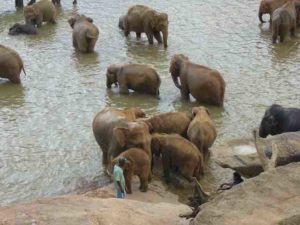
Sri Lanka touring – Part 1
Sri Lanka – getting there and more
.
.
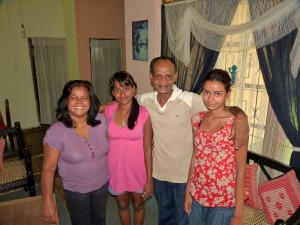
Sri Lanka touring – Part 2
.
.

Sri Lanka racing
The racing and even more touring
TRAVEL DETAILS
AIRPLANE
Los Angeles, CA (LAX) – Washington, D.C. (IAD) – 2,285 miles
Washington, D.C. (IAD) – Dubai, UAE (DXB) – 7,050 miles
Dubai, UAE (DXB) – Colombo, Sri Lanka (CMB) – 2,040 miles
PRIVATE DRIVER
Bhandarnaike International Airport (Colombo) – trip begins
All over Sri Lanka! – 260 kilometers (It seemed like much more!)
Bhandarnaike Intercontinental Airport (Colombo) – trip ends
AIRPLANE
Colombo, Sri Lanka (CMB) – Dubai, UAE (DXB) – 2,040 miles
Dubai, UAE (DXB) – Washington, D.C. (IAD) – 7,050 miles
Washington, D.C. (IAD) – Los Angeles, CA (LAX) – 2,285 miles
Total air miles – 22,750 – (6 flights)
Total private car miles – 162 (1 car)
Total miles traveled on this trip – 22,912 miles
Official end of the RLR – Randy Lewis Racing Trackchaser Report


